Orchid was a graphics and sound card manufacturer for the IBM PC and its compatibles.
They formed in the mid-80s designing and producing memory expansion and CPU upgrade boards. Popular products from Orchid include the RamQuest series of intelligent memory expansion cards, and the Tiny Turbo 286 and Twin Turbo CPU upgrade boards.
 EGA EGA
Launched: 1986
Bus: ISA 8-bit
Memory: 256 KB
FCC ID:
Known BIOS Versions:
Known Board Revisions:
The Orchid EGA was a graphics adapter compatible with the IBM Enhanced Graphics Adapter (EGA) standard.
The Orchid EGA supported the standard 640 x 350 in 16 colours from a palette of 64, with full backward-compatibility to MDA, CGA and Hercules standards. The EGA BIOS was claimed to be 300% faster than the IBM EGA one.
Brochure |
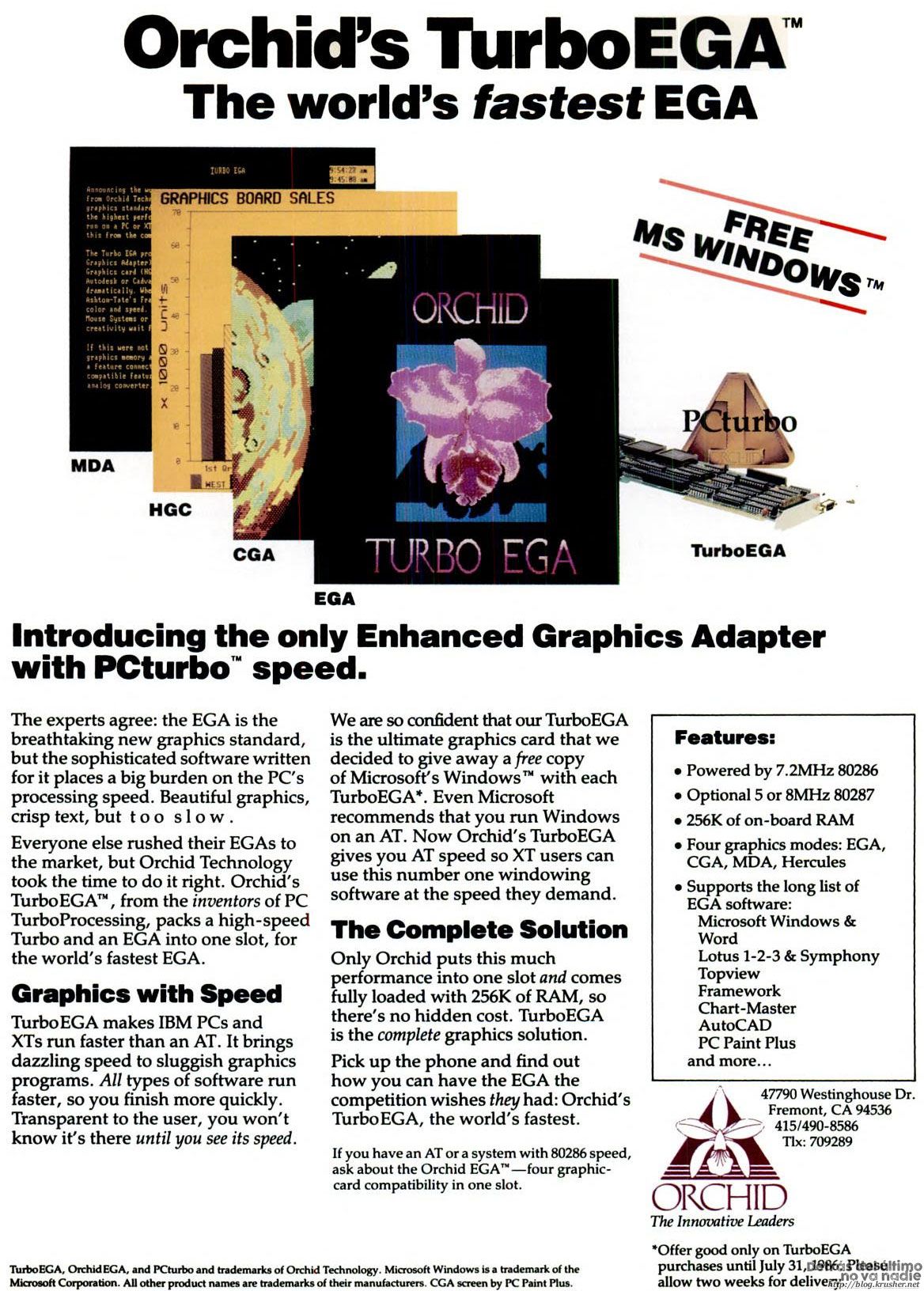 Turbo EGA Turbo EGA
Launched: 1986
Bus: ISA 16-bit
Memory: 8 KB onboard cache
FCC ID:
Known BIOS Versions:
Known Board Revisions:
A rather unique expansion card that combined Orchid's TinyTurbo 286 accelerator and their EGA card into one solution.
The Turbo EGA supported the standard 640 x 350 in 16 colours from a palette of 64, with full backward-compatibility to MDA, CGA and Hercules standards. The EGA BIOS was claimed to be 300% faster than the IBM EGA one.
The TinyTurbo 286 side of the Turbo EGA replaced the Intel 8088 processor via a ribbon cable into the CPU socket, providing your PC with an 80286 running at 7.2 MHz. It could also be fitted with an Intel 80287 math coprocessor. A toggle switch on the backplate could be used to switch between the 80286 and 8088 (which you reinstalled onto the TurboEGA board) for compatibility.
Brochure |
 Turbo PGA Turbo PGA
Launched: 1987?
Bus: ISA 16-bit
Memory: 320 KB
FCC ID:
Known BIOS Versions:
Known Board Revisions:
The Orchid TurboPGA was a fast graphics adapter compatible with the shortlived IBM Professional Graphics Adapter (PGA). By using its onboard Intel 80186 CPU it was able to achieve typically five times the performance of the IBM board.
Offering resolutions up to 640 x 480 in 256 colours from a palette of 262,144, it was aimed at the CAD and professional imaging markets.
Brochure |
 Designer VGA / Pro Designer VGA / Pro Designer VGA+ Designer VGA / Pro Designer VGA / Pro Designer VGA+
Launched: 1989
Bus: ISA 16-bit
Memory: ?
FCC ID:
Known BIOS Versions:
Known Board Revisions:
Price: $349 (Jan '89), $279 (PD VGA, Nov '89), $369 (PD VGA+, Nov '89) |
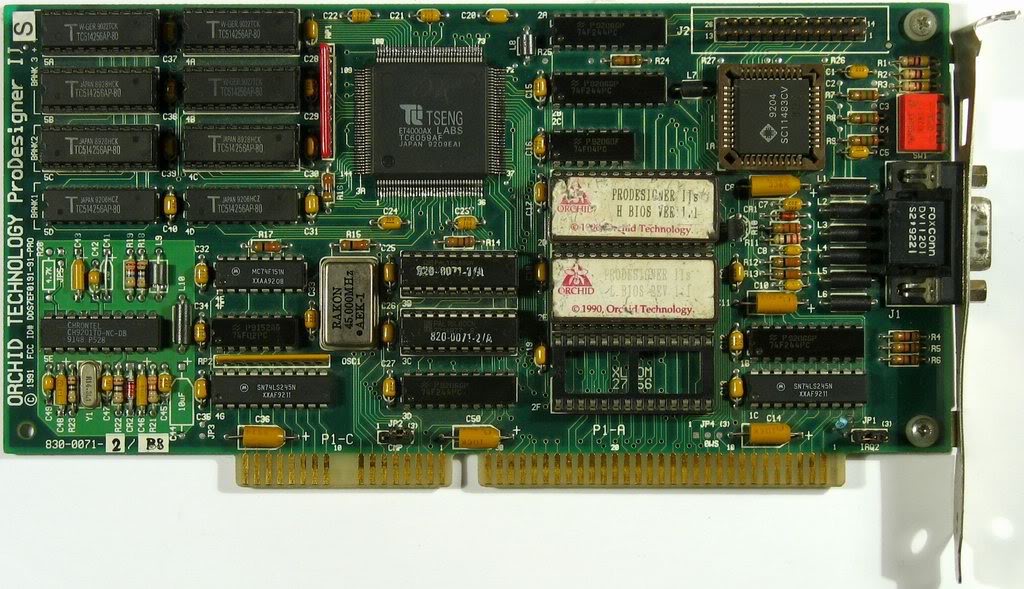 Pro Designer II / IIs Pro Designer II / IIs
  
Launched: 1991
Bus: ISA 16-bit
Memory: 512 KB or 1 MB
FCC ID: DDS7EF0191-91-PRO
Known BIOS Versions: 1.1, 3.3, 5.0
Known Board Revisions: 1A, 1C, 2/08,
2/810
Price: $569 (PDII, Apr '91), $304 (PDII, Aug '91), $184 (PDIIs, Aug '91), $199 (PDIIs 512K, Oct '91), $219 (PDIIs, Feb '92), $129 (PDII 512K, Oct '91)
The ProDesigner IIs provides up to 32768 colours with the 1 MB video RAM version, and if the Sierra HiColor RAMDAC is installed, the maximum resolution at this colour depth is 1024 x 768.
"PROS: Fast AutoCAD performance
CONS: Expensive
The most outstanding feature of the Orchid ProDesigner II is speed—it tied for first place in the key AutoCAD tests. Other than that, the board has an average set of features and a fairly high $304 street price.
Like most boards in this roundup, the ProDesigner II offers flicker-free 72 Hz performance at all resolutions except 1024 by 768. That may limit your options, but on today's 14-inch multiscans, most people won't experiment beyond 800 by 600 anyway.
The board isn't quite plug and play, but unless a network board is present, you probably won't have to mess with the board's handful of jumpers. Driver installation involves issuing commands from the DOS prompt instead of simply choosing menu options.
Thanks to its speedy performance, AutoCAD users may want to consider this board seriously. In addition, by the time you read this, Orchid will be shipping a new version of the ProDesigner II (the IIs) that will list for $120 less and purportedly will offer the same speed, 70-Hz refresh at 1024 by 768, and a special upgrade that will support over 32,000 colors under Windows. These new features should make the Pro-Designer IIs one of the hottest Super VGA boards around." PC World, August 1991
It is one of those rare cards that will work in either an 8-bit or 16-bit ISA or EISA slot, with auto-detection to switch to 8 or 16-bit data transfer speeds.
User Manual
Driver Disk (1 x 5.25" floppy)
More Images
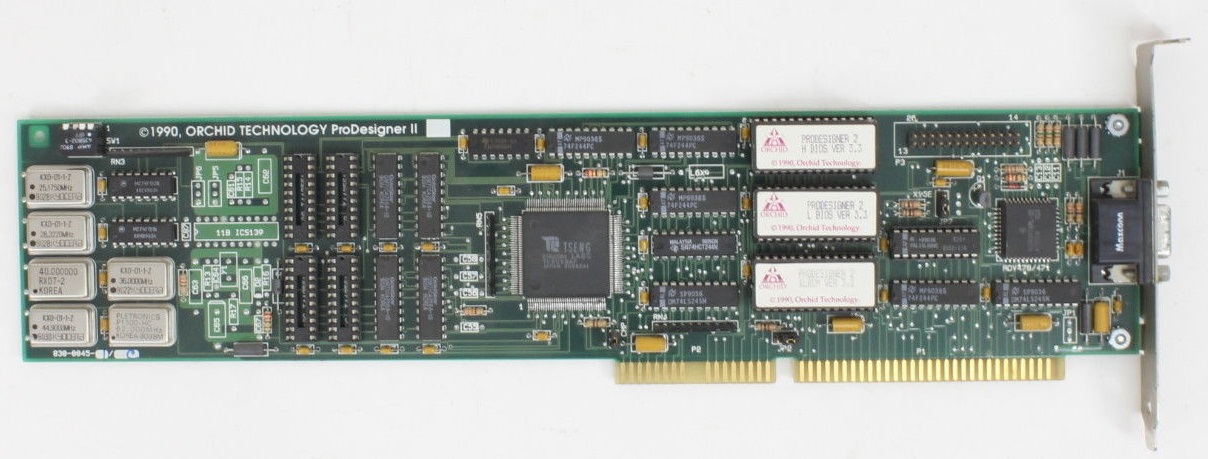 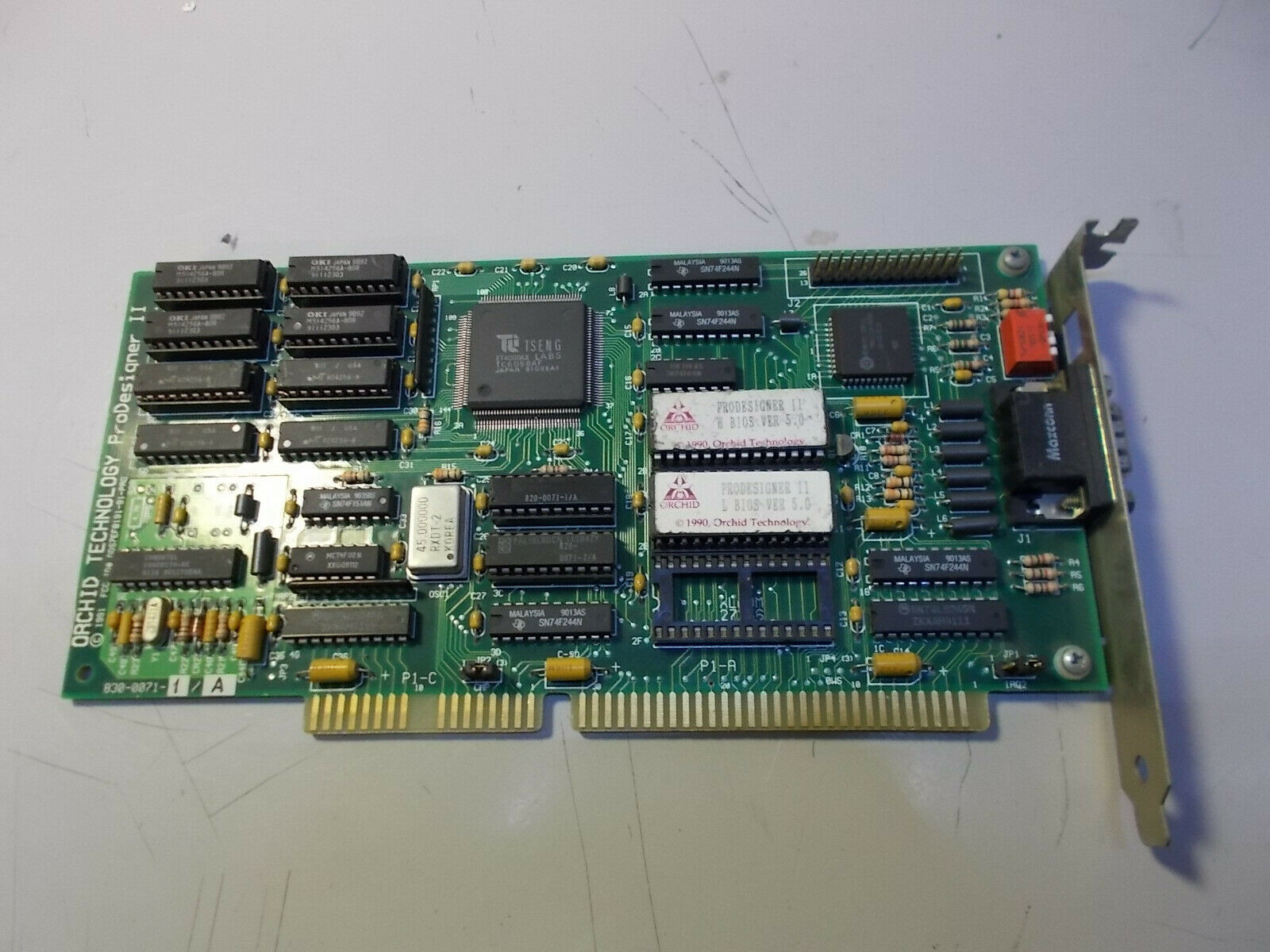
|
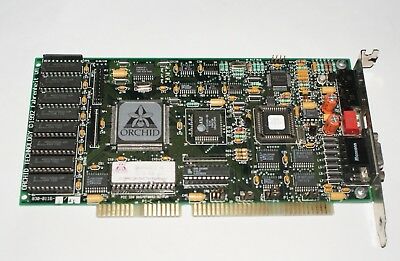 Fahrenheit Fahrenheit
    
Launched: 1991
Chipset: S3 86C801
Bus: ISA 16-bit
Memory: 1 MB
RAMDAC Speed: 80 MHz
Price: $329 (Jun '92)
|
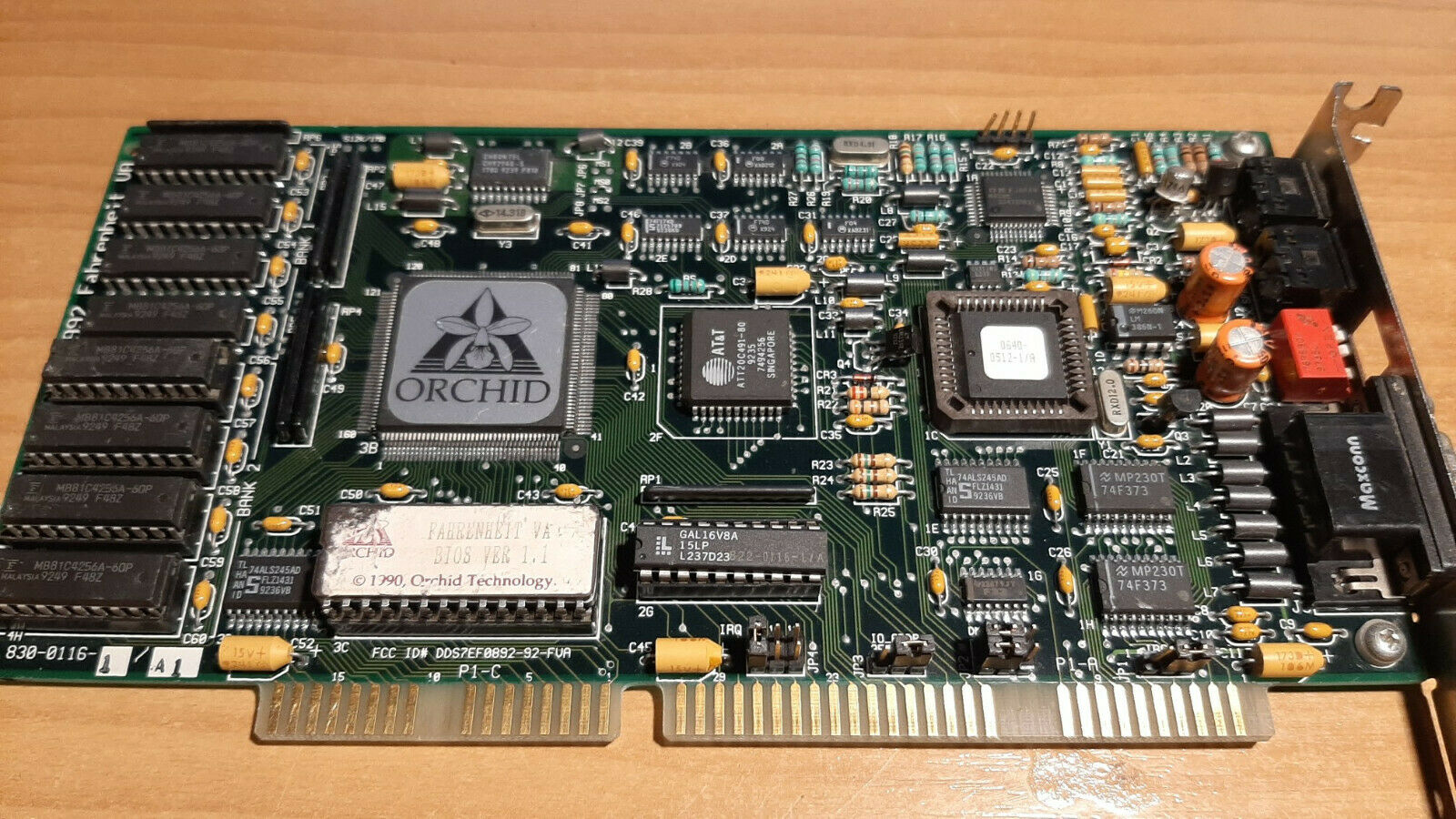 Fahrenheit VA and VA/VLB Fahrenheit VA and VA/VLB
    
Launched: 1993
Chipset: S3 86C801
Bus: 16-bit ISA and VESA Local Bus
Memory: 1 MB or 2 MB
Price: $299 (Apr 1993)
The Fahrenheit VA was an interesting card that also provided a $50 audio option. This included a mono microphone input, stereo speaker outputs, and Orchid's Voice Notes utility to help turn your pc into a multimedia system. that also provided a $50 audio option. This included a mono microphone input, stereo speaker outputs, and Orchid's Voice Notes utility to help turn your pc into a multimedia system.
It's important to note that the audio side of this card *does not* provide Ad Lib or Sound Blaster compatibility, nor does its "multimedia" orientation provide the card with any CD-ROM interface. I did a retro review of this card in January 2023.
"The leader of the pack is the Orchid Fahrenheit VA, even though it does not accelerate raster operations or image transfers, nor does it do font caching. Priced at $299 with 1MB of RAM (no street discount), it achieves 13.40 megapixels-per-second at 800-by-600 and 12.61 at 1,024-by-768 in 256-color mode on our Graphics Winmark tests, better than many more-costly boards. At 16 colors, it racked up 10.20 and 10.16 megapixels-per-second in these resolutions, respectively.
The 86C801C-based $299 Orchid Fahrenheit VA, which comes with an audio option, is a little more expensive than other boards in its class. But with 1MB of RAM and Orchid's stable HyperDriver for Windows, this Editor's Choice winner delivered excellent Graphics Winmark scores in 256-color Super VGA and 1,024-by-768 modes, and it speedily handled our AutoCAD tests, unmarred by remnant pixels or an inability to clear the screen properly - something that plagued a couple of its competitors."
PC Magazine, April 1993
The Orchid Fahrenheit VA competed directly with other high-end cards including the ATI Graphics Ultra Pro, Hercules Graphite, Number Nine GXE, and Diamond Stealth Pro.
More Images
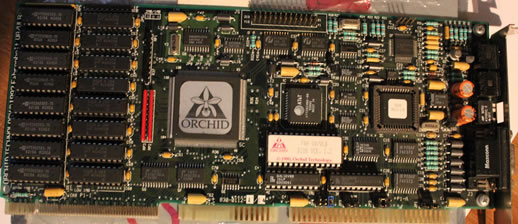 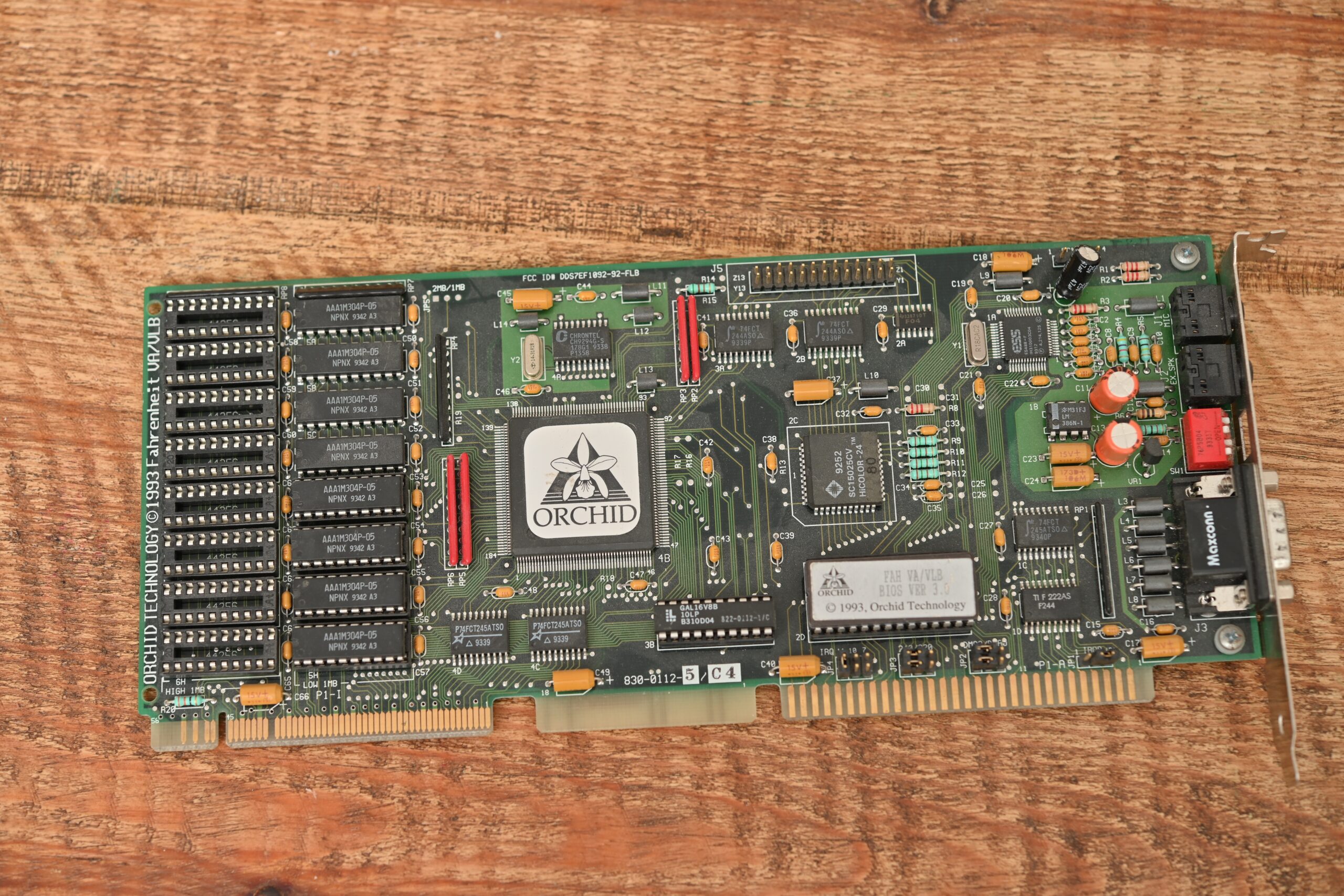
|
Fahrenheit 1280
    
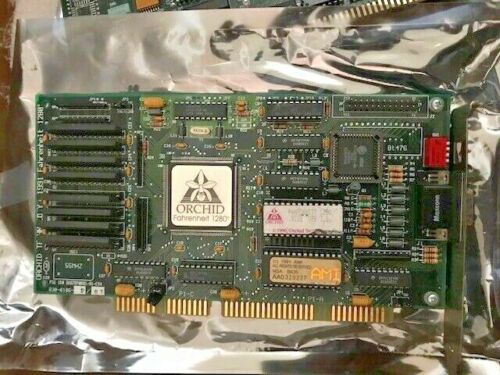 Launched: 1991 Launched: 1991
Chipset: S3 911/924 Pre&Vision (86C911) "Carrera"
Bus: ISA 16-bit
Memory: 512 KB or 1 MB VRAM
FCC ID: DDS7EF0691-91-ETH
Known BIOS Versions: 1.1, 1.2, 1.3, 2.1, 3.0
Known Board Revisions: 2/A4, 2/B2, 2/B3, 2/B4
Price: $449/$499 (512 KB/1 MB version), $319 (1280s HiColor, Feb '92), $299 (Mar '92)
The Fahrenheit 1280 supports resolutions up to 1280 x 1024 in 16 colours, 1024 x 768 in 256 colours, or 640 x 480 in 32,768 colours. The 1280 x 1024 resolution runs interlaced at 48 Hz, but 1024 x 768 can run non-interlaced at 70 Hz.
"At a street price of $357, Orchid's Fahrenheit 1280 compares very favorably to other boards, offering flicker-free screens, good performance, and an excellent warranty.
The Fahrenheit 1280 performed about average for an S3 card. It ran Excel and Word for Windows nearly 3 times faster than super VGA. PowerPoint ran at one-third the speed of super VGA, as usual.
The Fahrenheit 1280 operates flicker free except at its interlaced 1280 by 1024 resolution, and you get 32,768 screen colors at no extra cost. The board comes with drivers for numerous DOS programs, too. The warranty lasts four years, and technical support is super, if you don't mind paying for the telephone call. All told, the Fahrenheit 1280's low price and significant perks make it a good deal." PC World, March 1992
"Orchid Technology is shipping a new version of the Fahrenheit 1280 Windows accelerator board that provides 24-bit color at 480-by-640 resolution. The enhanced board provides a 7 percent performance gain over the original Fahrenheit, according to the company.
Orchid's proprietary Windows 3.1 software drivers contain a new setup utility that places mode and color selection controls into the Windows Control Panel. A 512K version of the Fahrenheit
1280 is also available and can be upgraded to 24-bit color capability with the addition of VRAM.
List Price:
Fahrenheit 1280 (1MB version), $399; Fahrenheit 1280 (512K version), $329." PC Magazine, August 1992
Compared to its competition at the time (Genoa WindowsVGA, STB Wind/X Ultra, and Diamond Stealth VRAM), it was a solid performer.
The similar Fahrenheit 1280 Plus is shown below. This card has FCC ID DDS7EF892-32-FGA:
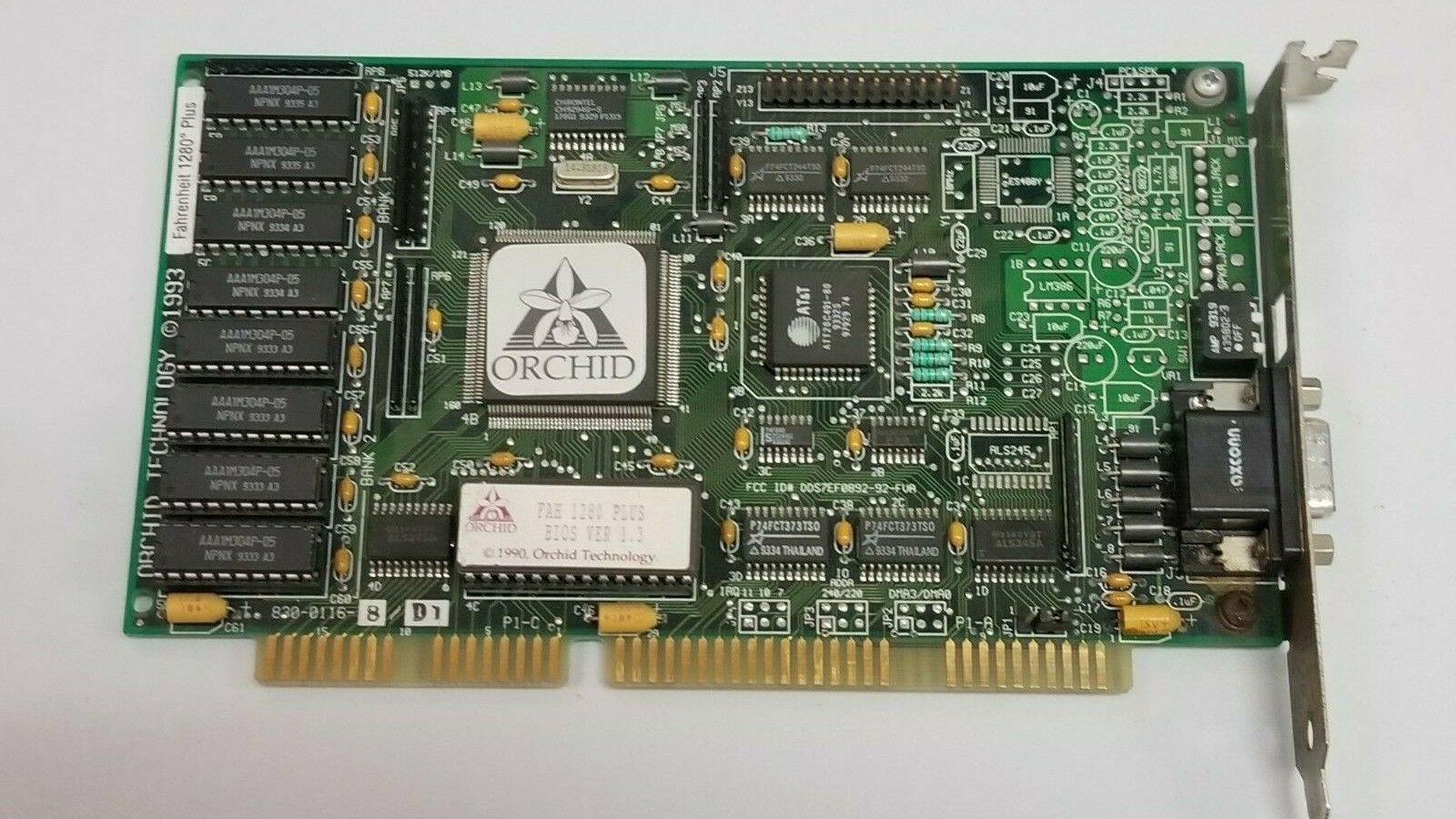 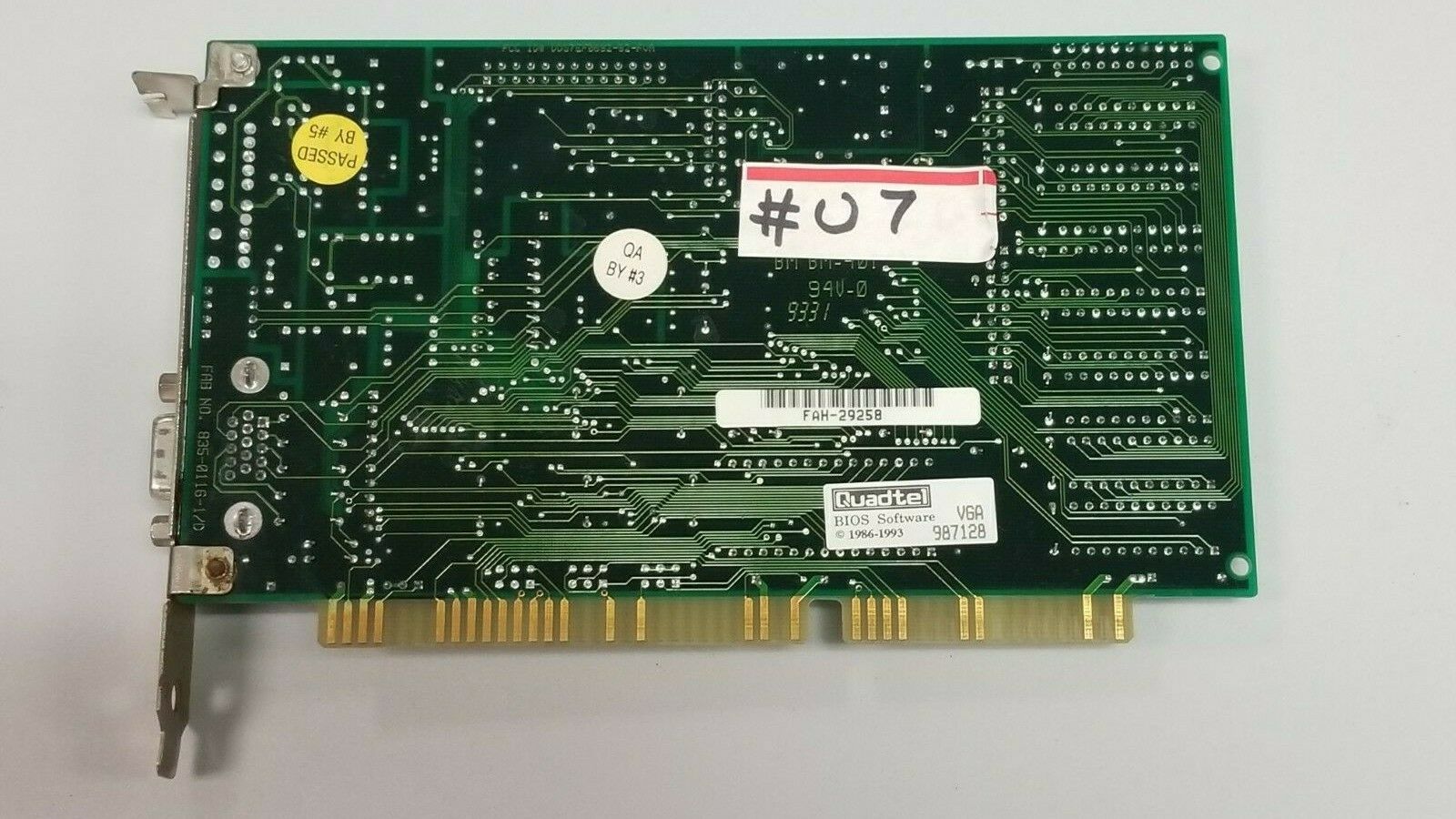 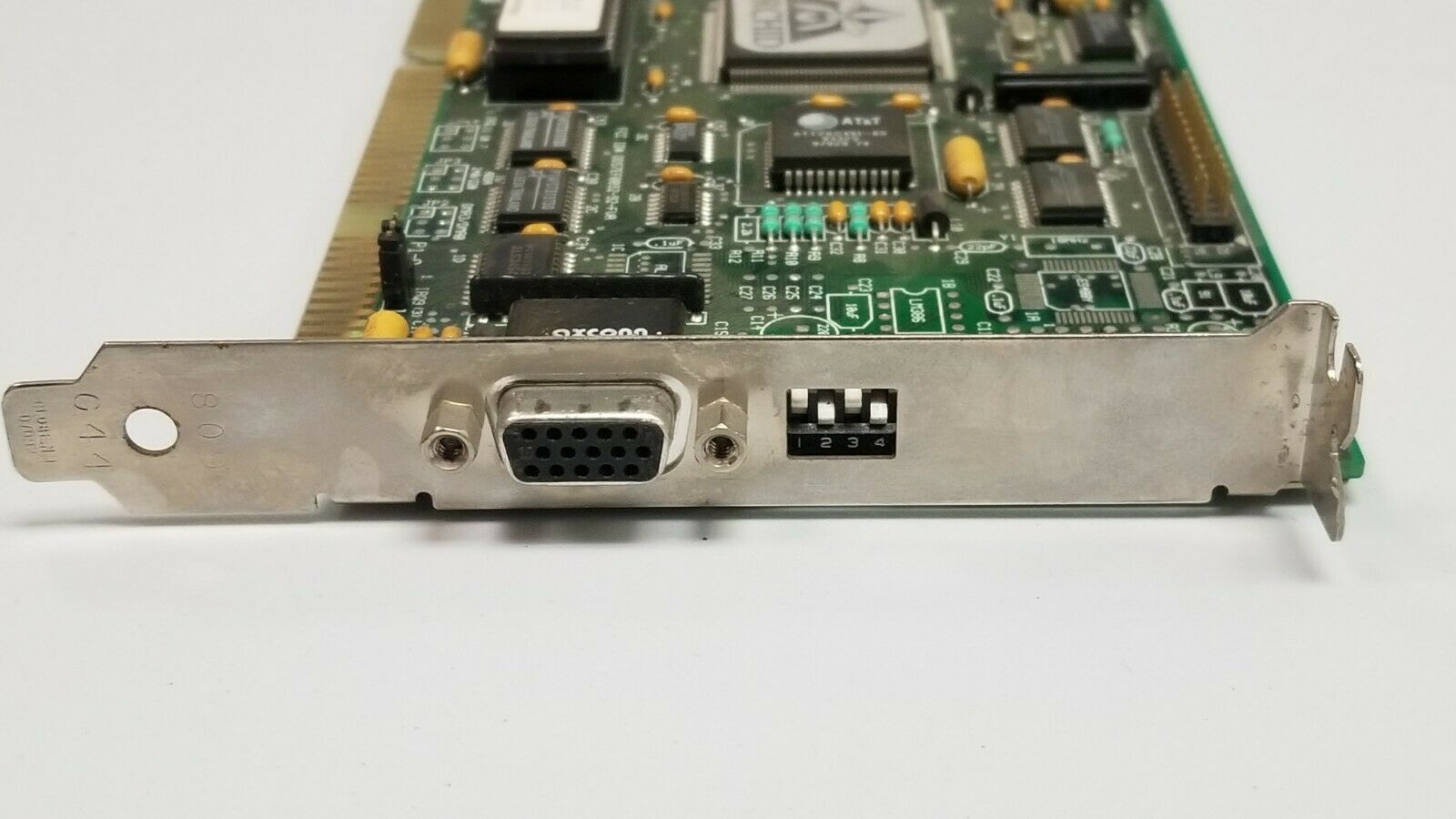
|
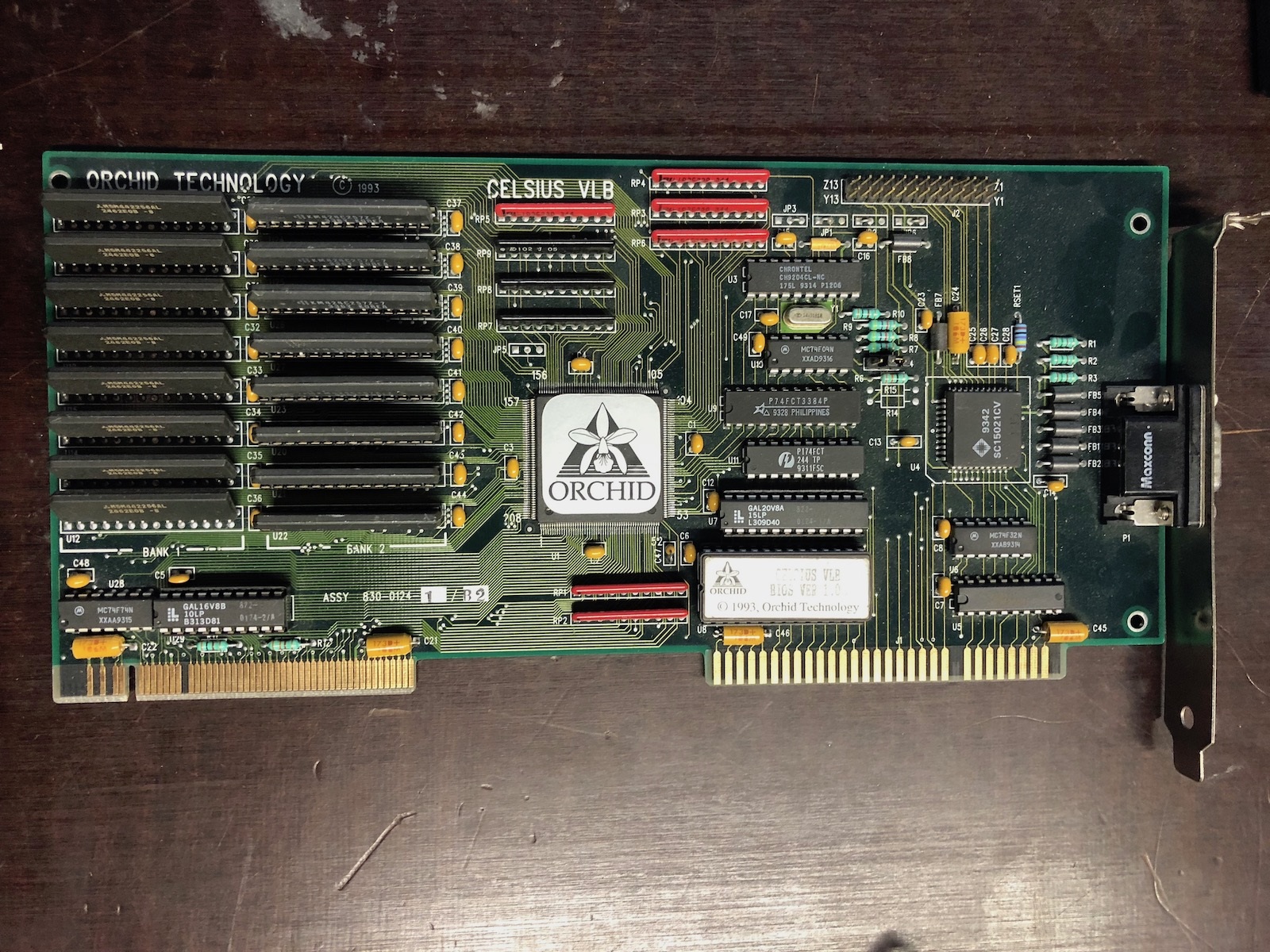 Celsius/VLB Celsius/VLB
    
Launched: 1993
Bus: VESA Local Bus
Memory: 1 MB VRAM (upgradable to 2 MB)
Price: $399 (Oct 1993)
Based on IIT's AGX015 graphics processor.
Supports up to 90 Hz flicker-free refresh rates, 16.7 million colours, and resolutions up to 1280 x 1024 (in 16 colours non-interlaced).
"Orchid Technology is shipping a new VESA local-bus Windows accelerator and a 16-bit digital signal processor (DSP) sound card. The Celsius/VLB, which has 1MB of video RAM, supports color dithering, polygon fill with reference pattern, polygon window mask, and image stretching and scaling. It can be upgraded to 2 MB of VRAM for 256 colors at 1,280-by-1,024 noninterlaced. It provides 16.8 million colors and a 90-Hz refresh rate."
PC Magazine, October 1993
User Manual
Driver Disk v1.3 (1 x 1.2MB floppy)
|
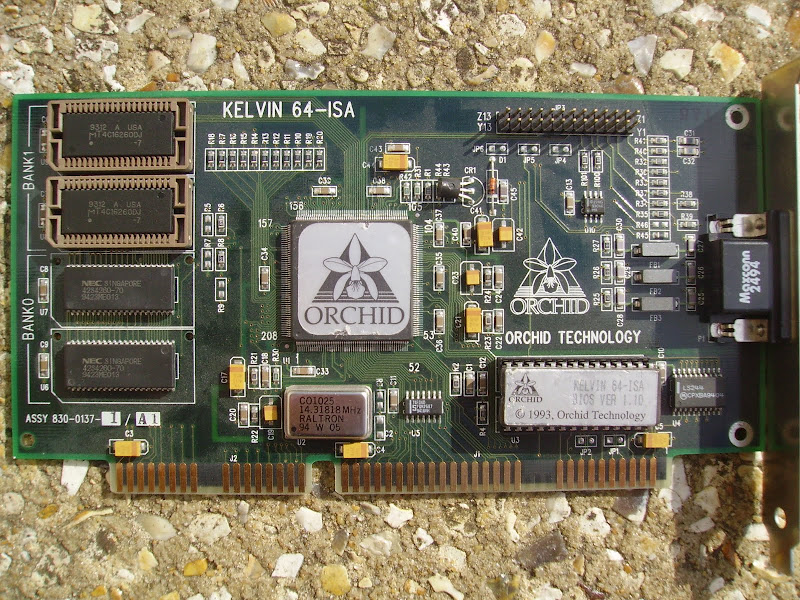 Kelvin 64 / EZ Kelvin 64 / EZ
    
Launched: 1994
Chipset: Alliance ProMotion 3210 or ProMotion 6410?
Bus: ISA, VLB, or PCI
Memory: 1 MB (upgradable) or 2 MB DRAM
Core Clock: 170 MHz
Price: ?
FCC ID:
DDS7EF1093-93-KVL (VLB), DDS7EFKELVI64-PCI (PCI)
Known BIOS Versions: 1.1, 1.10b
Known Board Revisions: 1C
The Kelvin EZ is a 32-bit version of Kelvin, supporting resolutions up to 1280 x 1024 and colours up to 16.8 million. Kelvin 64 was the first affordable 64-bit graphics accelerator available for ISA, VESA Local Bus and PCI.
The Kelvin 64 Video uses the Alliance ProMotion-3210 or ProMotion-6410. The 3210 is the 32-bit version of the 6410 and was the first video chipset to integrate video acceleration with PC graphics. The 6410 is the 64-bit version; a 2D Windows/VGA/motion video accelerator chipset. With a core clock that runs at up to 170 MHz, depending on the external DAC that accompanies it. With the full 2 MB of EDO or FPM DRAM memory it supports a maximum resolution of 1600 x 1200.
User Manual |
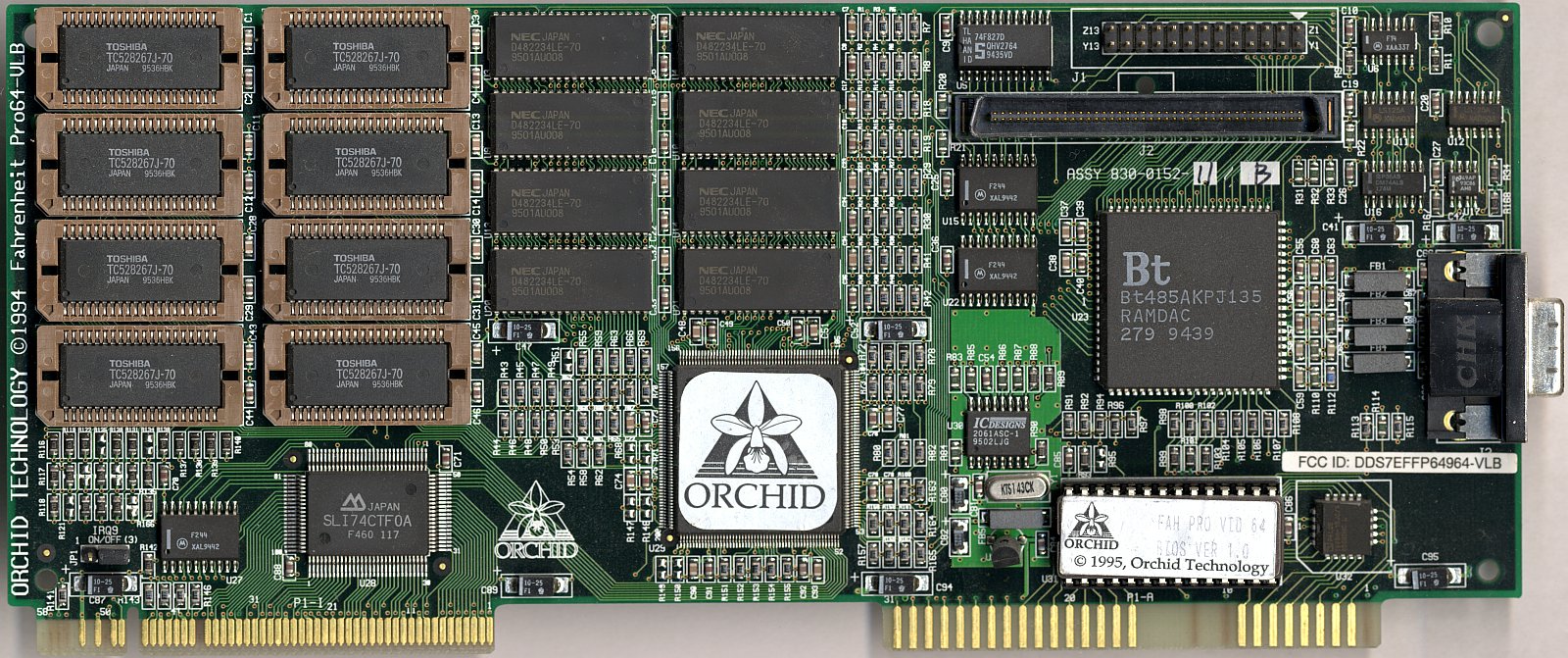 Fahrenheit ProVideo 64 Fahrenheit ProVideo 64
    
Launched: 1994
Chipset: S3 Vision 968 (86C968)
Bus: PCI or VESA Local Bus
Memory: 2MB (upgradable) or 4MB VRAM
RAMDAC: Bt 485
FCC ID: DDS7EFFP64964-VLB
Known BIOS Versions: 1.0
Known Board Revisions:
Price: ?
Maximum resolution is 1600 x 1200 and supports refresh rates up to 120 Hz.
Has hardware digital video scaling capabilities, colour space conversion and dithering.
|
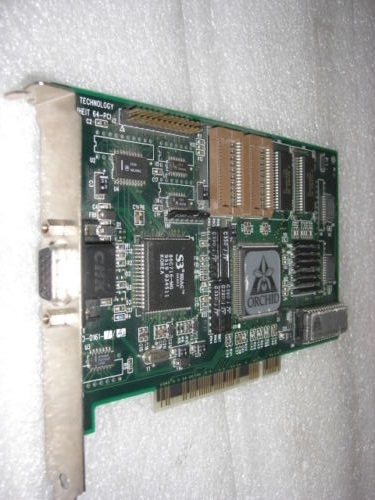 Fahrenheit 64 Fahrenheit 64
   
Launched: 1995
Chipset: S3
86C716
Bus: ISA 16-bit or PCI
Memory: 1 MB (upgradable) or 2 MB DRAM.
Price: ?
Displays 16.8 million colours at a resolution of 800 x 600 (2 MB cards only). Highest resolution is 1280 x 1024. Refresh rates up to 75 Hz.
User Manual |
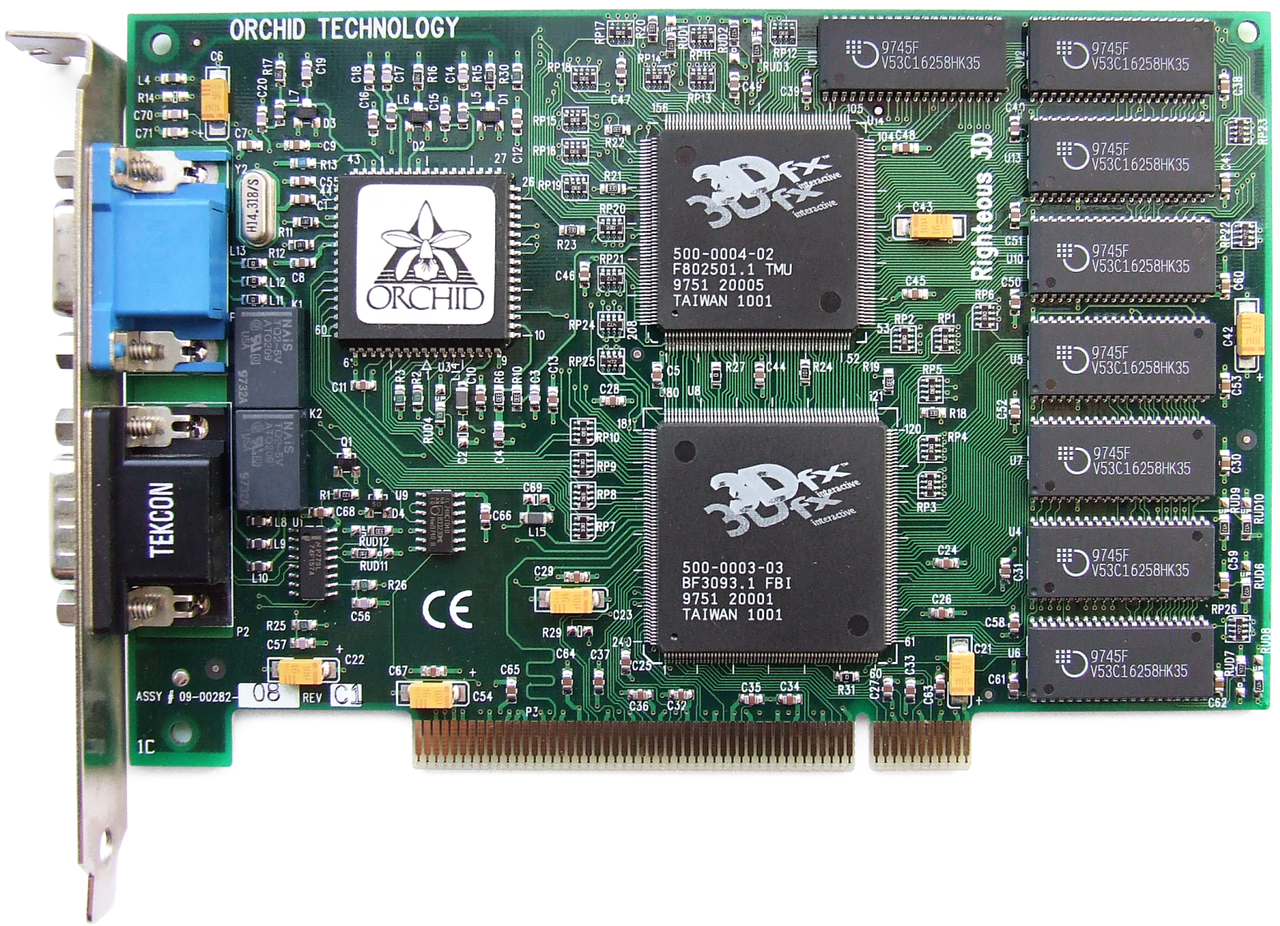 Righteous 3D Righteous 3D
Launched: 1995
Chipset: 3dfx Voodoo
Bus: ISA 16-bit or PCI
Memory: 4 MB
FCC ID:DDS7EFF06964M3DFX
Price: ?
The Righteous 3D was a licenced build of the 3dfx Voodoo 3D graphics accelerator, so requires a separate 2D graphics card for operation. |
 Fahrenheit Pro64 Fahrenheit Pro64
   
Launched: 1995
Chipset: ?
Bus: PCI or VESA Local Bus
Memory: 4 MB VRAM
Price: ?
Maximum resolution is 1280 x 1024. Supports high speed horizontal and vertical acceleration in all display modes.
Displays 16.8 million colours at a resolution of 1024 x 768. Refresh rates up to 120 Hz.
User Manual
|
 Kelvin Video64 Kelvin Video64
   
Launched: 1995/1996
Chipset: Alliance Semiconductor ProMotion 6410
Bus: PCI
Memory: 1 MB (upgradable) or 2 MB DRAM
FCC ID: JYBPCI3210D
Known BIOS Versions: 3.15
Known Board Revisions: D
Price: £294 (2MB, Sep '95)
Display resolution up to 1600 x 1200, colour depth up to 16.7 million colours.
I'm not sure if the Alliance ProMotion 641 is different from the 6410, but the 641 was used on the Alaris Matinee and Focus OptiView Pro graphics cards.
User Manual
|
 Kelvin MPEG Kelvin MPEG
   
Launched: 1995/1996
Chipset:
Bus: PCI
Memory: 1 MB (upgradable) or 2 MB DRAM
Price: ?
Video playback up to 1280 x 1024 at 30 frames per second in 24-bit colour.
User Manual
|
 Fahrenheit Video 3D Fahrenheit Video 3D
   
Launched: 1996
Bus: PCI
Memory: 2 MB EDO DRAM.
Price: ?
3D graphics accelerator features Bi-Linear and Tri-Linear filtering, MIP mapping and Gouraud shading, perspective correction, video texture mapping, depth cueing and fogging, alpha blending and Z-buffering.
Maximum display resolution is 1600 x 1200.
User Manual |
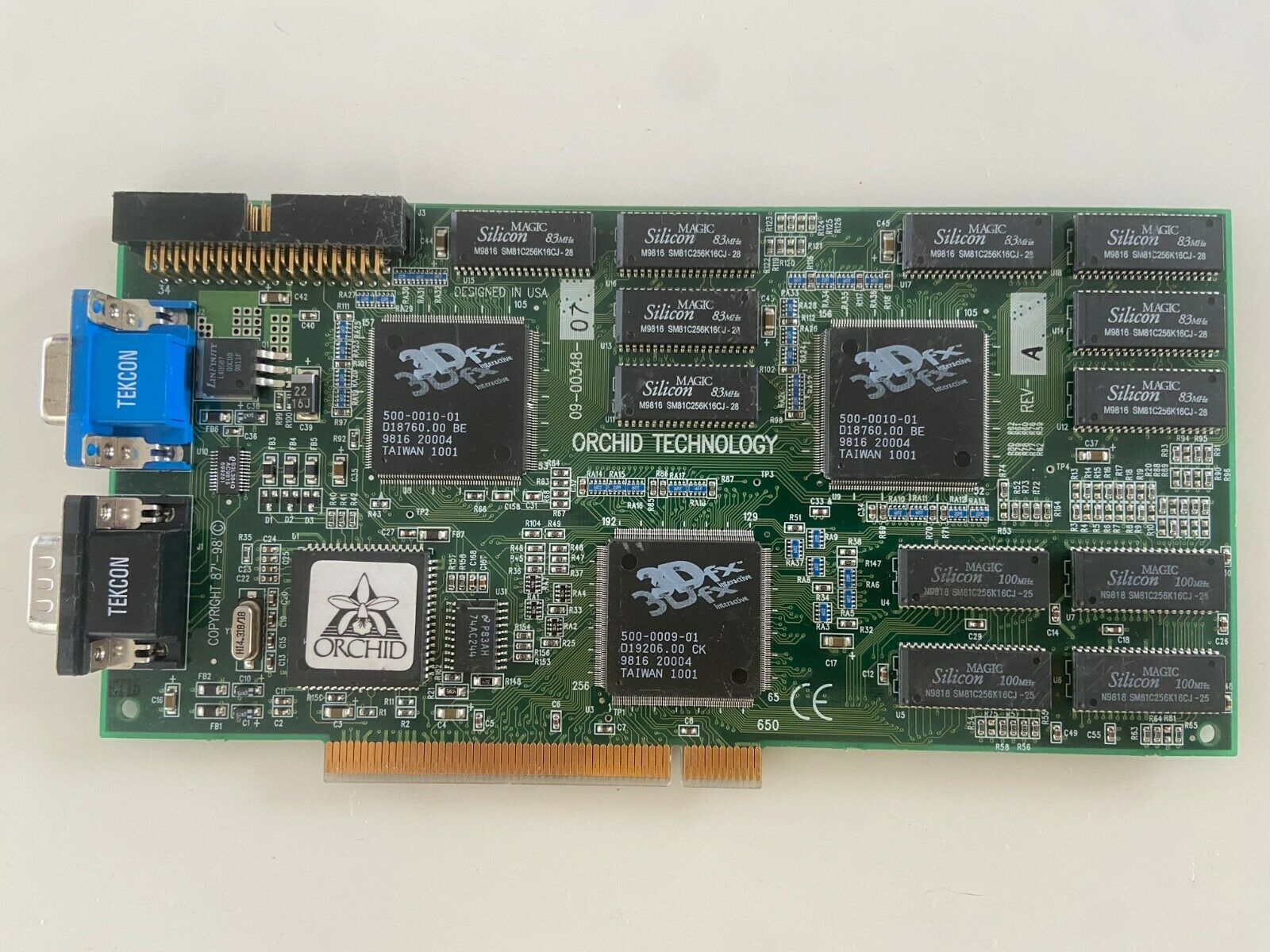 Righteous 3D II Righteous 3D II
Launched: 1998
Chipset: 3dfx Voodoo 2
Bus: PCI
Memory: 12 MB
FCC ID:
Price: $299 (list price at launch)
The Righteous 3D II was a licenced build of the 3dfx Voodoo II 3D graphics accelerator, so required a separate 2D graphics card for operation.
The Righteous 3D II got a second texture unit over the original Righteous 3D (Voodoo Graphics), and video memory was increased to 12 MB.
"Like the original Diamond Monster 3D, Orchid's Righteous 3D was a very popular 3D accelerator. The second-generation Righteous 3D II seems a good bet to continue as a fan favorite - if it's able to stick around on the market long enough.
As we went to press, Diamond Multimedia had announced plans to acquire Orchid Technologies. This acquisition has not been finalized, however, and the future of the Righteous 3D II has not yet been decided.
The Righteous 3D II performance scores were in line with those of the Creative Labs 3D Blaster Voodoo2 on each version of our 3D WinMark test. On the Quake II test, the Orchid card achieved a respectable score, just barely breaking into 68-frame-per-second territory (at 68.2).
Those who used the original Righteous 3D card will find the new card's driver control panel very familiar. Although it is somewhat crowded and less intuitive than the Canopus and Quantum 3D applets, it offers a wealth of features and options for fine-tuning its performance (including the memory clock speed adjuster). Of note on the driver control panel is the button that links you to Orchid's online manual and technical support numbers.
The Righteous 3D II's software bundle is satisfying, although not overwhelming. It includes demo versions of Battlezone, G-Police, Incoming, and Jedi Knight: Dark Forces II.
Our overall impression of the Righteous 3D II was that it's a solid, reliable accelerator card, which will most likely be popular among existing Orchid customers. In a head-to-head comparison, however, the Canopus Pure3D II LX and the Diamond Monster 3D II come out on top."
PC Magazine, October 1993
|
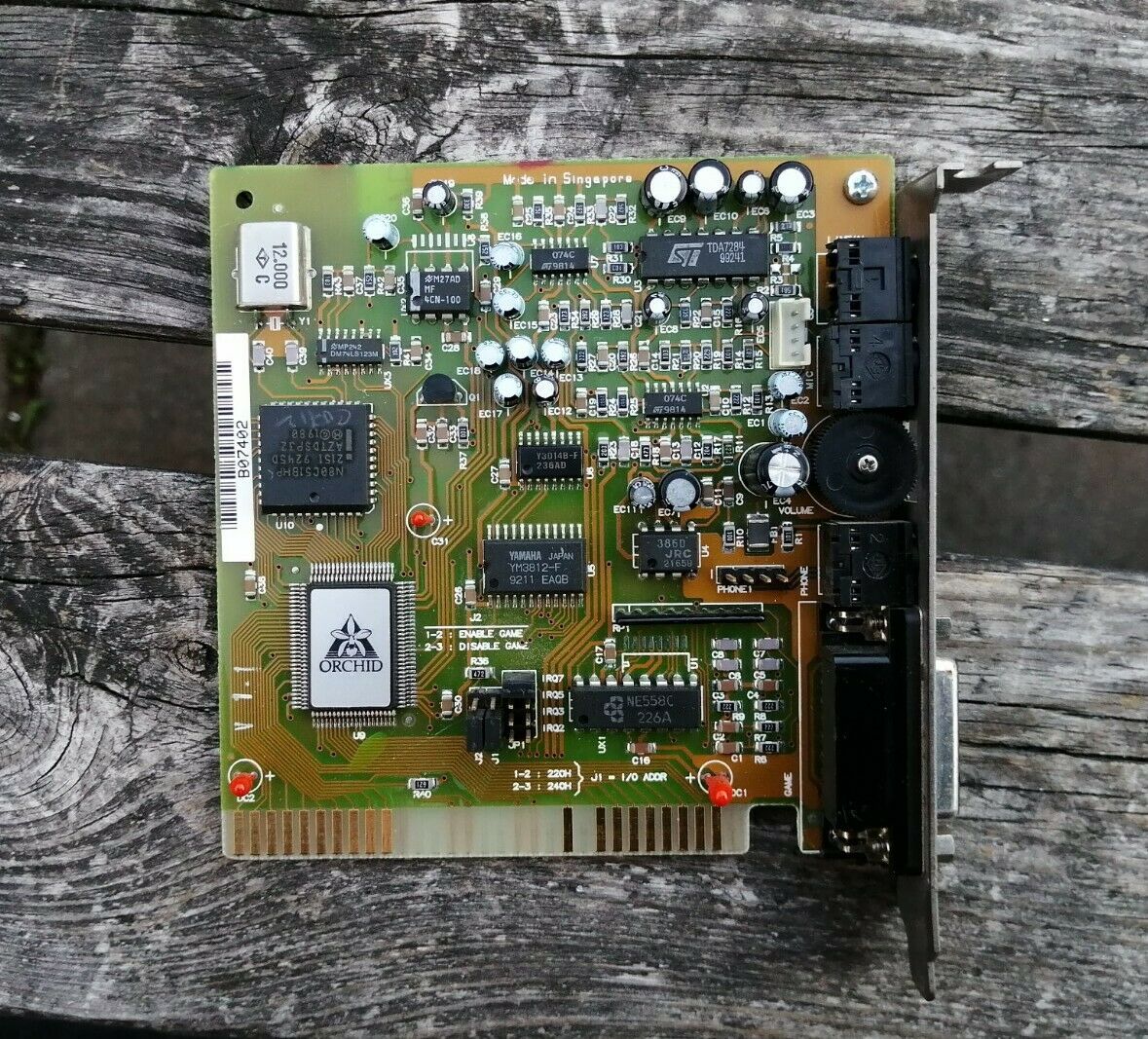 Sound Producer Sound Producer  
FM synthesizer: Yamaha YM3812-F
Audio codec: Aztech AZTSB0792-U07
Interface: 8-bit ISA
Plug & Play: No
Model No.: SP-7524
FCC ID: I38-SGBX21
Price when New: £40
The Orchid Sound Producer is an officially licenced version of the Aztech Sound Galaxy BX II, so the Aztech drivers should work just fine with this card.
Supports Ad Lib and Sound Blaster. |
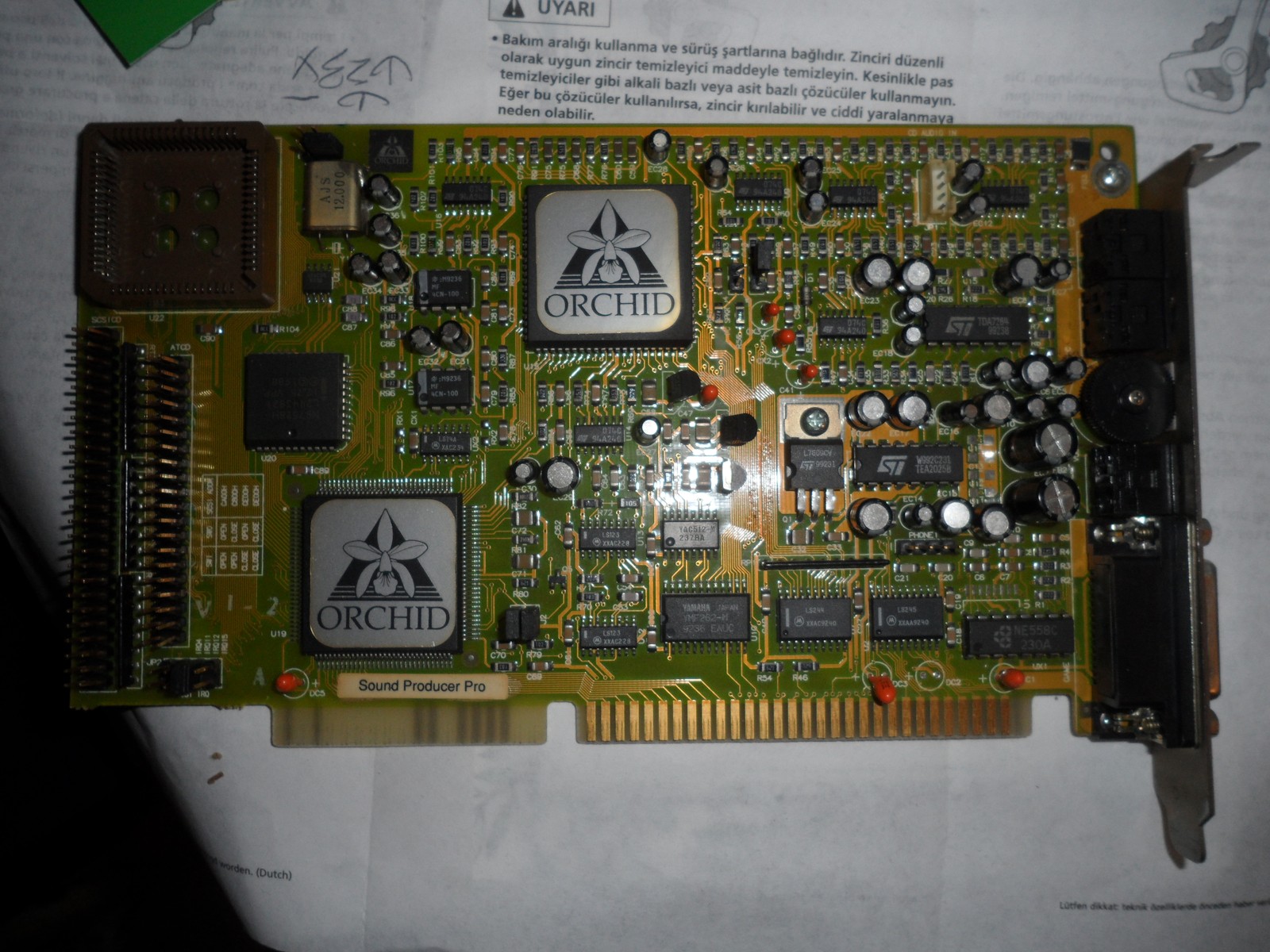 Sound Producer Pro Sound Producer Pro     
Launched: 1992
FM Synthesizer: Yamaha YMF262-M (OPL3) or LS-212.
Chipset: Aztech AZTSSPT0592-U01 (1st generation card).
DAC: Yamaha YAC512
Plug & Play: No
Price when New: ?
Supports Ad Lib, Sound Blaster Pro II, Disney Sound Source and Covox Speech Thing.
20-voice stereo FM synthesizer.
Recording sampling rate is 4 KHz to 44.1 KHz (mono) or 4 KHz to 22.05 KHz (stereo)
Built-in ISA CD-ROM drive interface. Optional SCSI CD-ROM interface.
Game port has MIDI interface.
4W amplifier.
The Orchid Sound Producer Pro is a rebadged Aztech Sound Galaxy NX Pro.
User Manual
|
 GameWave GameWave
Launched: 1994
FM synthesizer: ?
Audio codec: ?
Price when New: $110
Rich Heimlich said this of the GameWave: "A less expensive and less impressive version of the SoundWave 32. In this case, that's not a very good thing.". It scored 2 out of 10 for digital quality and 1 out of 10 for music quality. |
 SoundDrive 16 SoundDrive 16   
Launched: 1994
FM synthesizer: ?
Audio codec: ?
Price when New: -
Supports Ad Lib, Sound Blaster, and Microsoft Windows Sound System.
User Manual |
 GameWave 32 GameWave 32    
Launched: Jan 1994
FM synthesizer: ?
Audio codec: ?
DSP: Analog Devices ADSP2115
Price: $169 (launch list price), $110 (launch street price), £99 (Mar 1995)
Supports Ad Lib, Sound Blaster, General MIDI, Roland MPU-401 interface and Roland MT-32.
GameWave 32 has either 512 KB or 1 MB ROM for samples onboard. These samples, known as "Prosonus", are compressed, so it is likely with the 512 KB ROM version you get 1 MB of compressed samples, and with the 1MB ROM version you get 2 MB of compressed samples. ROMs can be optionally upgraded to the 2 MB InVision ones (see SoundWave32 with InVision further down for details). These came with over 200 recorded instrument samples.
The card had an onboard DSP (Digital Signal Processor) that was apparently capable of 20 MIPS.
Sony and Mitsumi CD-ROM interfaces.
User Manual |
GameWave 32 Plus    
Launched: 1994
FM synthesizer: ?
Audio codec: ?
DSP: Analog Devices ADSP2115
Price when New: $169
The GameWave 32 Plus cards were identical to GameWave 32, but shipped with the InVision ROMs, which were an optional extra for the original SoundWave 32 card.
InVision Interactive were based in Palo Alto, CA., and were well-known in the musical instrument industry for providing the highest quality CD-ROM samples for professional music sampling platforms. Among other things, InVision also designed a library of sounds specifically for the ESS ES689 wavetable.
"The GameWave 32Plus is more expensive than the [Gravis UltraSound] ACE and the [Turtle Beach] Monte Carlo, but it sounds cheap. It produced the poorest wavetable sound of any board tests-flatter and more muffled than the other cards.
Orchid also skimps on the software, providing only DOS and Windows control panels. The one bright spot: an excellent 4-year warranty. The GameWave has Sony and Mitsumi CD-ROM drive interfaces."
Electronic Entertainment, 1994-1995
User Manual |
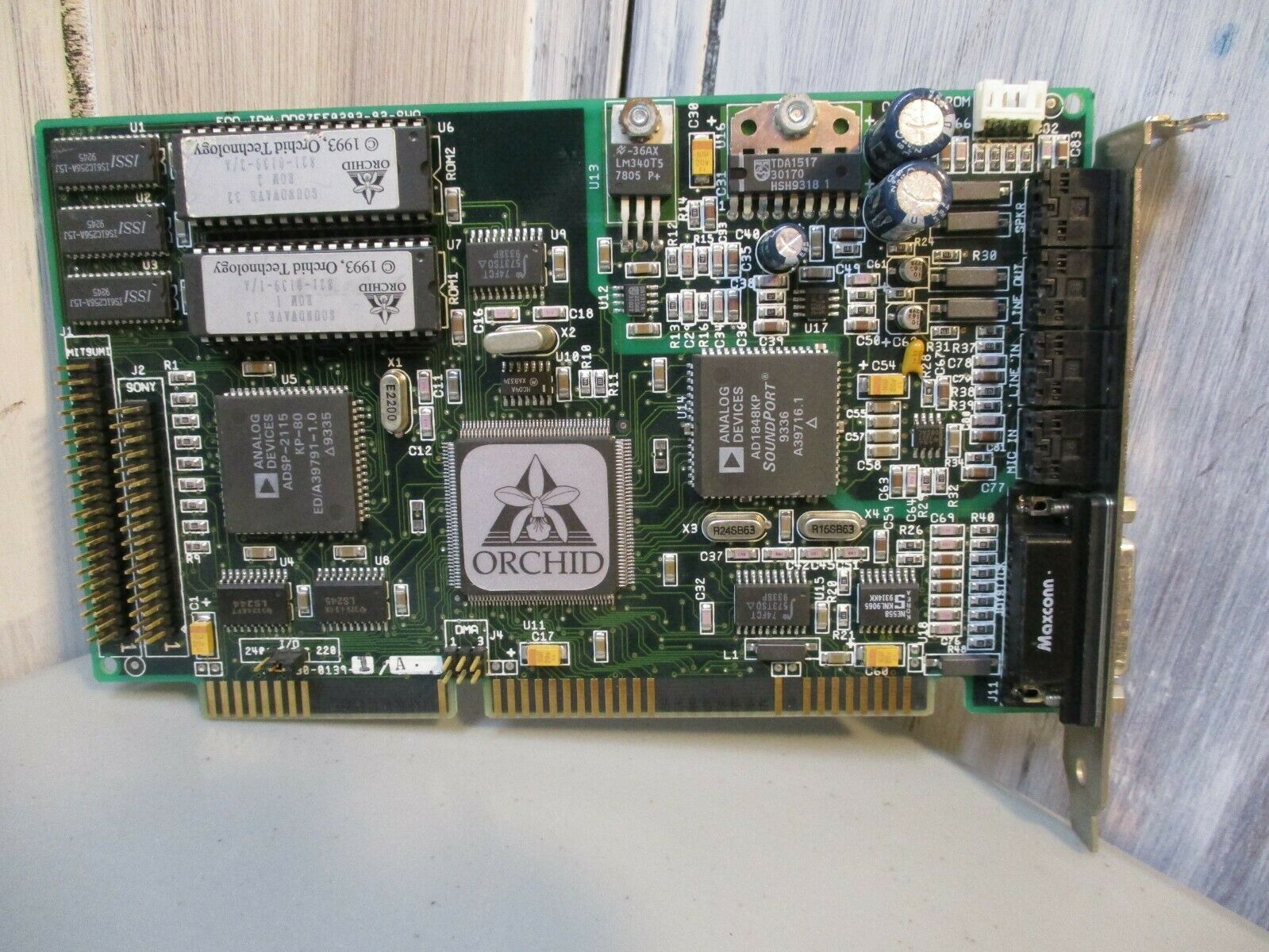 SoundWave 32 SoundWave 32      
Launched: 1993
FM synthesizer: OPL2 FM emulation
Audio codec: Analog Devices AD1848KP
DSP: Analog Devices ADSP2115
Signal to Noise Ratio: -74.5 dB
Price: $299 (Oct 1993), $249 (1994), £159 (Mar 1995)
FCC ID: DDS7EF0393-03-SWA
Known Board Revisions: 835-0139-1/A, 835-0139-1/B, 835-0139-1/C
Supports Ad Lib, Sound Blaster Pro, Microsoft Sound System, General MIDI, Roland MPU-401 interface and Roland MT-32.
SoundWave 32 has either 512 KB or 1 MB ROM of samples onboard. These samples, known as "Prosonus", are compressed, so it is likely with the 512 KB ROM version you get 1 MB of compressed samples, and with the 1MB ROM version you get 2 MB of compressed samples.
Both the Doom and Descent games pages have sample OPL4 audio from this card.
One interesting thing about the SW32 is that you can load up different DSP firmwares for General MIDI mode and Roland MT-32 mode, which tell us that there is also some kind of LA Synthesis that is emulated. The usual MT-32 emulation does not feature this.
"Also new from Orchid is the SoundWave 32, which supports a variety of sound and multimedia formats including AdLib, SoundBlaster, Windows Sound System, and general MIDI. It's based on the Analog Devices ADSP2115 DSP, which processes over 20 million instructions per second."
PC Magazine, October 1993
"Today's sound boards face the challenge of integrating new standards and capabilities while offering quality coverage for existing features and formats.
Orchid Technology's SoundWave 32 board is a $299 solution to this problem. Its two Analog Devices processors give true 16-bit audio processing at a maximum sampling rate of 44.1 kHz
for full CD sound quality. Meanwhile, its ROMs hold 8 megabytes of instrument and sound effect samples that give you 24 simultaneous voices in Sound Blaster/Yamaha OPL2 or General MIDI mode and 32 in Roland MT-32 modes. The chip sets work in concert to support simultaneous processing of sound emulations in combination with its core Sound Blaster, Microsoft Sound System, and Roland MPU-401 MIDI modes and interfaces.
With digital sound processing based in its 20-MHz Analog Devices ADSP-2115 chip, the 16-bit board is designed with integrated interfaces for Sony and Mitsumi CD-ROM drives, too. It also has an external 15-pin
joystick/MIDI port connection and a full array of line, speaker, microphone, and CD audio inputs/outputs. There are no external volume controls on either the board or its included unpowered speakers, but the SoundWave driver software and one of the board's bundled software packages gives you access to the board's audio settings.
In addition to its DSP, the SoundWave board has the Analog Devices 1848 CODEC, a version of the same chip used in Microsoft Sound System to handle analog-to-digital and digital-to-analog conversions with space-saving compression."
PC Magazine, December 1993
The chip at the bottom, usually covered with a silver Orchid sticker is an Analog Devices Echo ESC614.
There are 3 known board revisions, with the 'A' revision not having a jumper to tell the board if a 512 KB or 1 MB patchset is installed (assume it only supported the former). The 'B' and 'C' revisions added this jumper. Also differences in the ROMs themselves, with 820-, 821-, and 810- prefixes. The 820 and 821 both seem to only be on 'A' revision board, while the 810 ROMs are only on the 'B' and 'C' revision boards.
Other sound cards that are very similar to the SW32 include the Beethoven ADSP-16 (no wavetable) / ADSP-16 Wave (with wavetable chips), Cardinal MPC700/DSP16, and the Wearnes Peripherals MML9050 (PA-WP9050-B) - these both use a combination of the Analog Devices AD1848KP, Analog Devices Echo ESC614 and Analog Devices ADSP-2115.
Driver Disks - Contains v1.3, v1.4 and v2.1 driver versions - only difference v1.x and v2.x is in the .LD DSP microcode files
User Manual
Advert (October 1993)
Here is a dump of the two standard 512 KB Prosonus ROMs: ROM1, ROM2
More Images
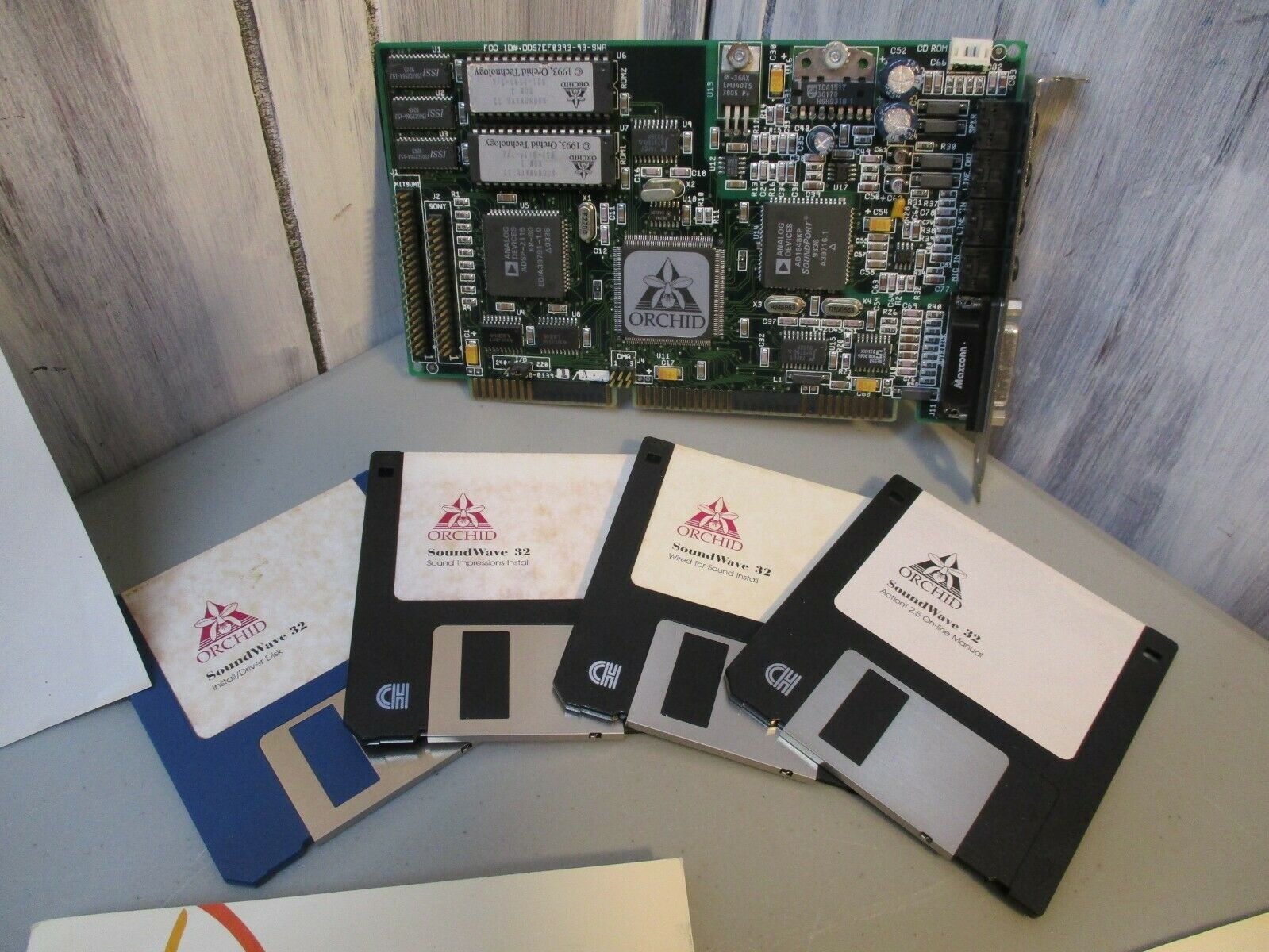 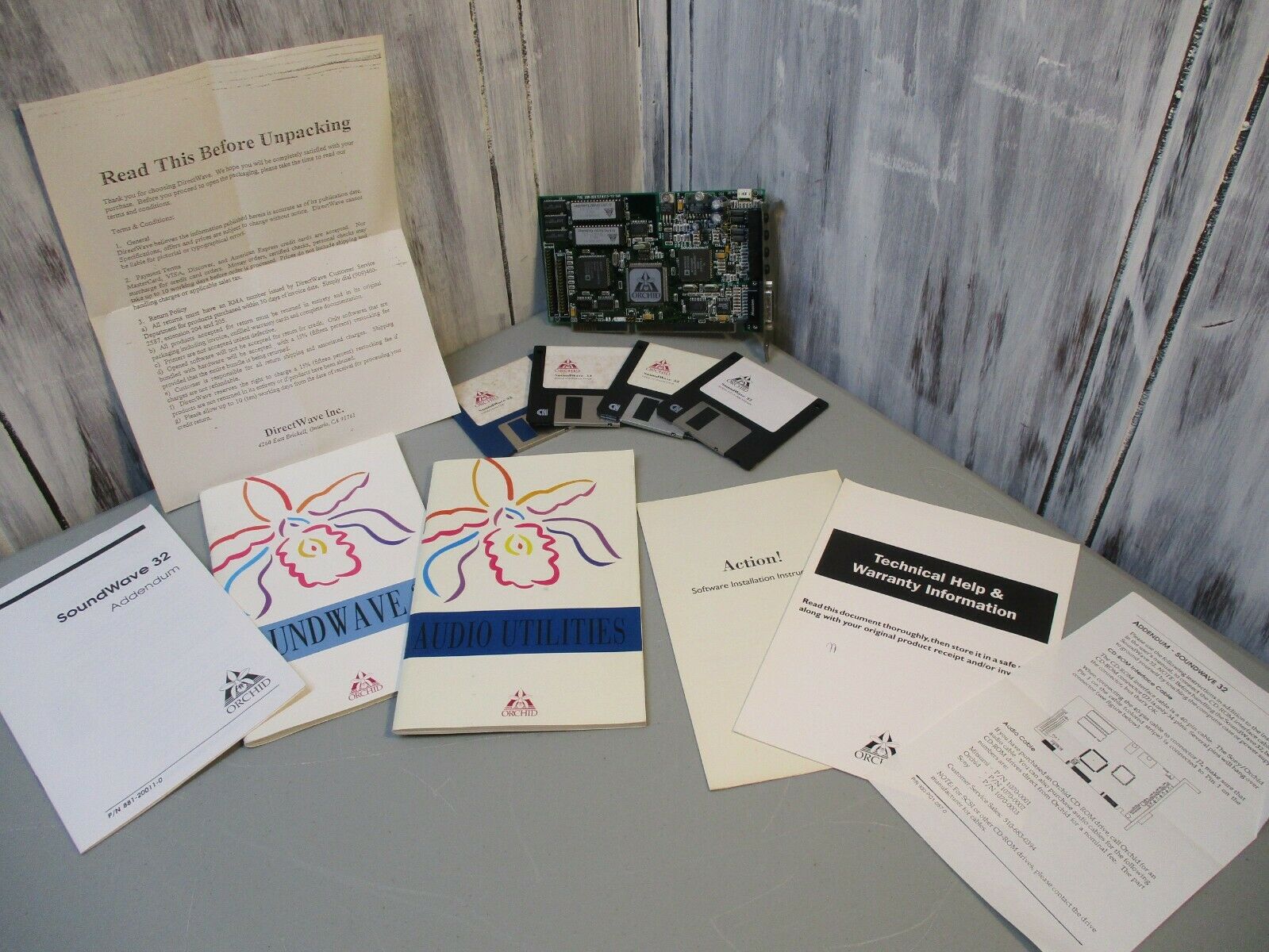 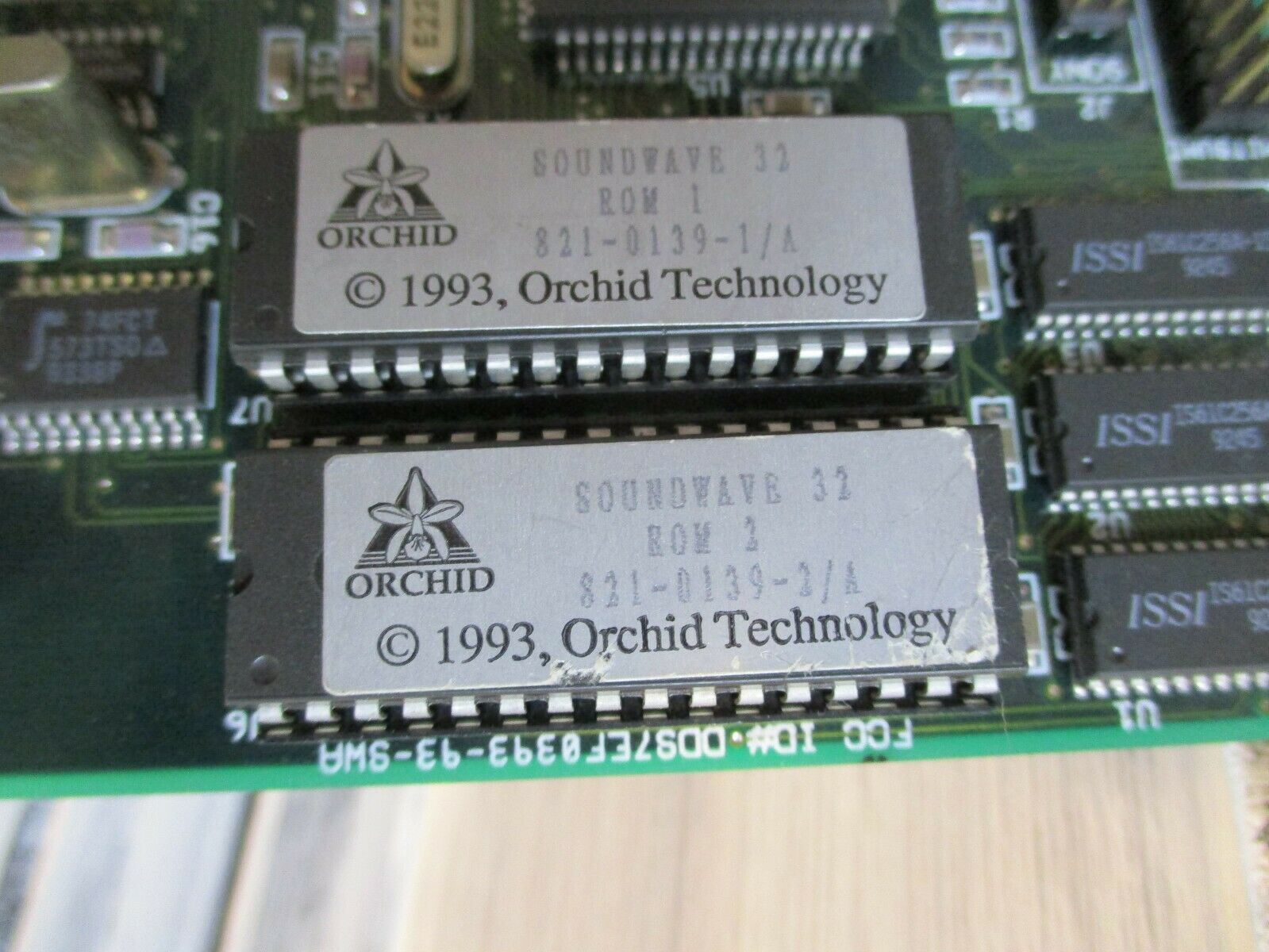 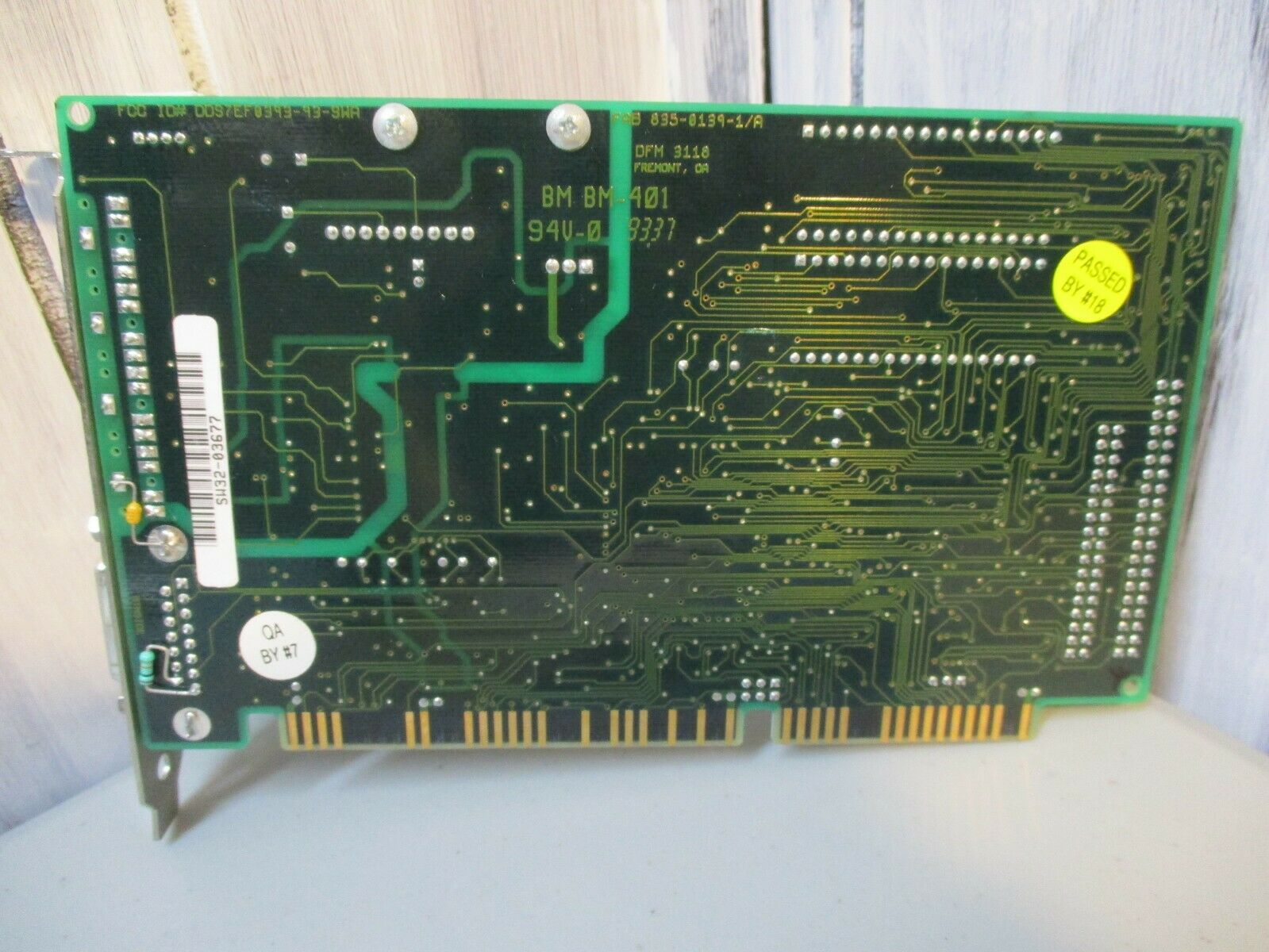 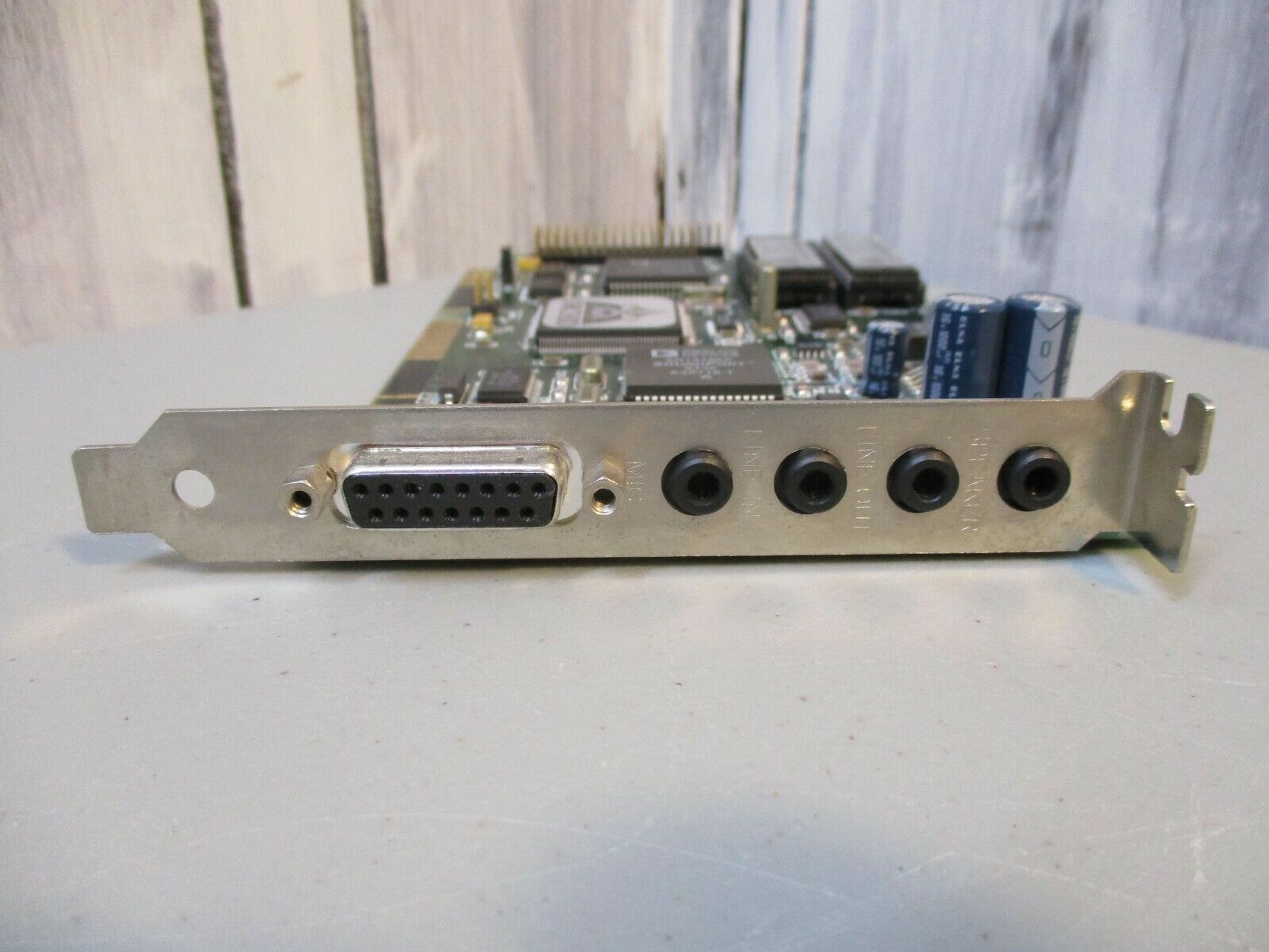 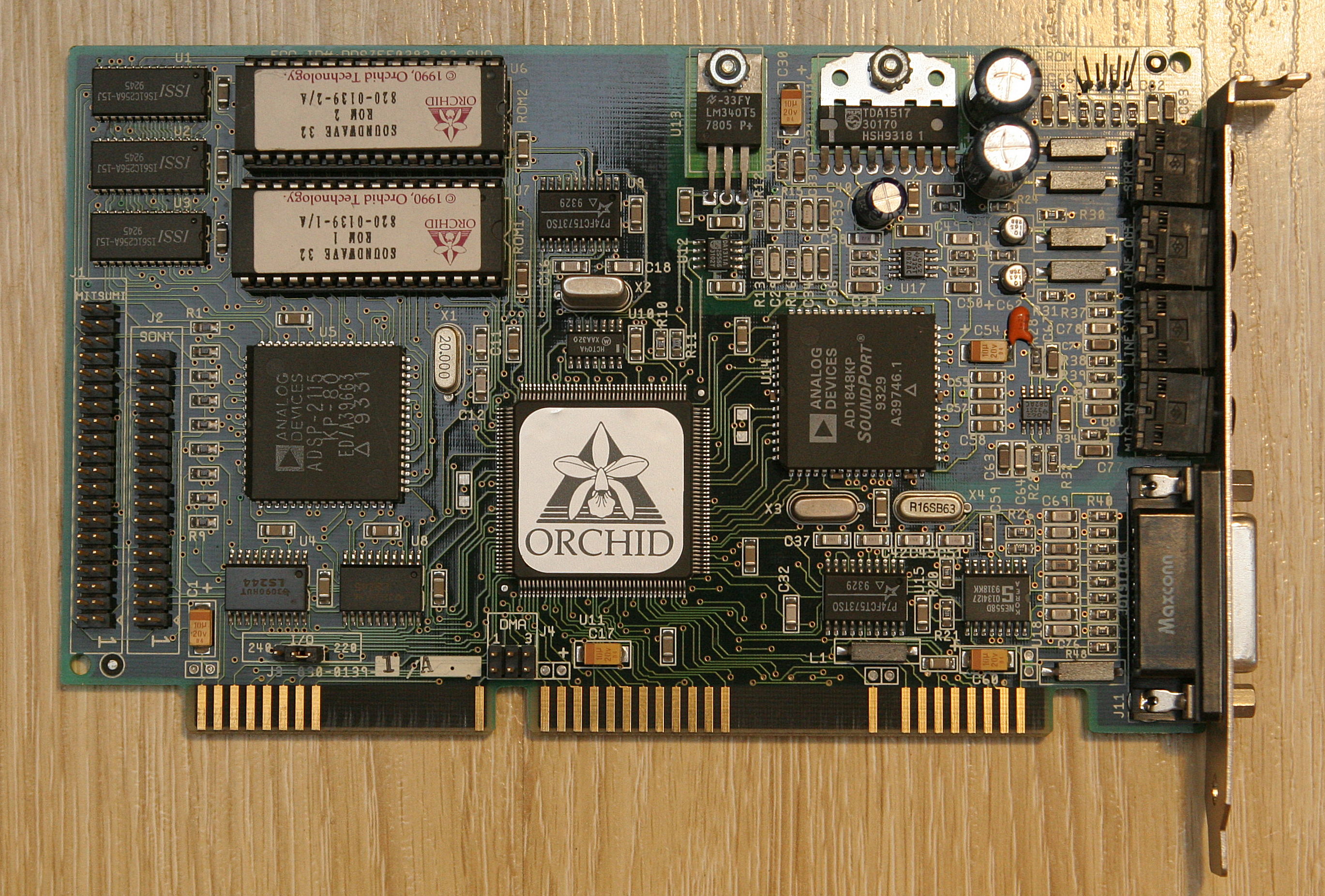
|
SoundWave 32 with InVision       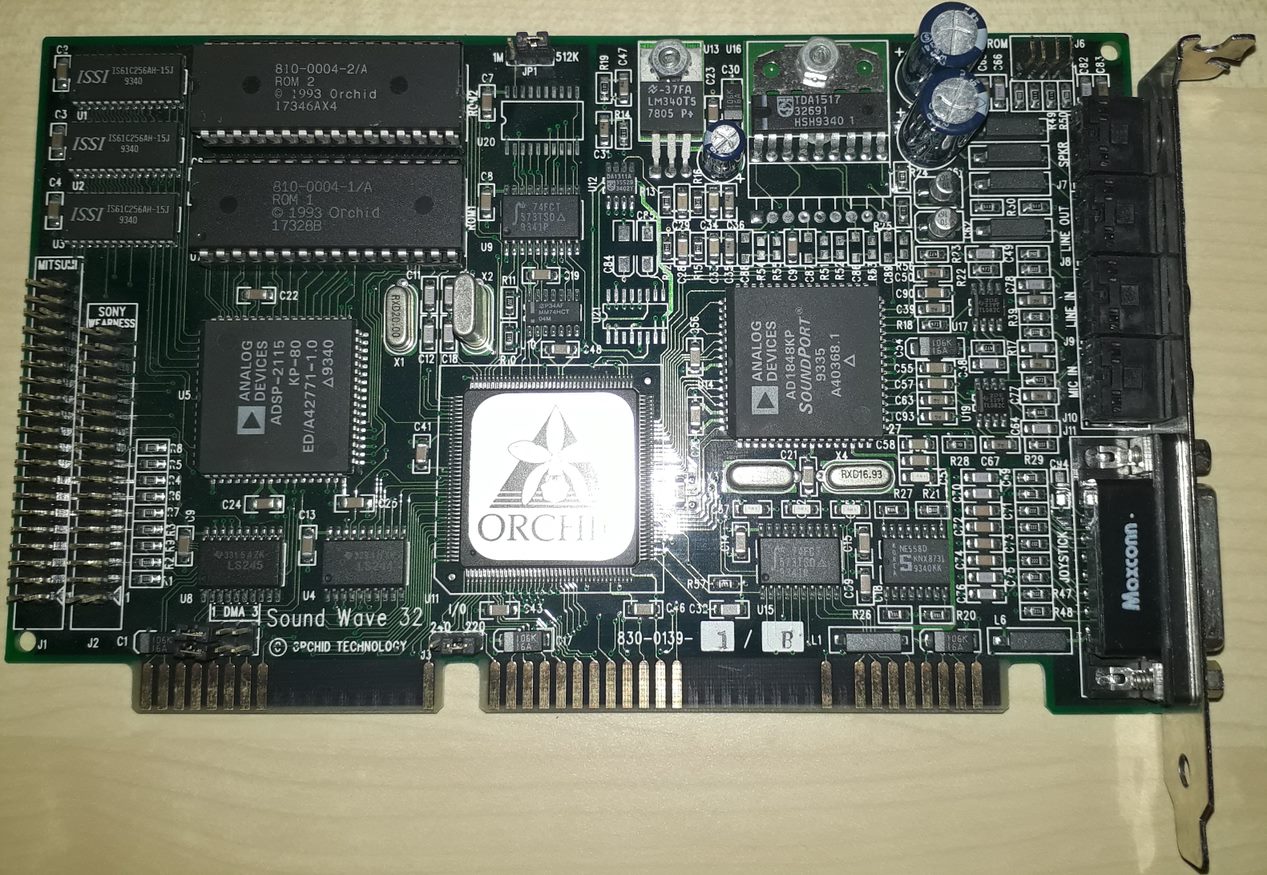
Launched: 1994
FM synthesizer: OPL2 FM emulation
Audio codec: Analog Devices AD1848KP
DSP: Analog Devices ADSP2115
Price: $289 (1994)
FCC ID: DDS7EF0393-03-SWA
This is a SoundWave 32 but with different ROMs (so a different patchset to the Orchid standard SW32 card) from InVision Interactive. InVision, based in Scotts Valley, CA., were mostly known for developing an ROM card for the Korg M1, named "M1 Plus 1", and their Lightware AKAI samples in co-production with North Star and Sound Genesis. They also produced sample ROM expansions for EMU Proteus.
This card comes with different drivers (2.x) and also new DSP firmware (.LD files for General MIDI and Roland MT-32). You could buy the InVision ROMs for approx $40 back in the day.

" InVision Interactive, a supplier of sound samples for leading
synthesizer manufacturers (Korg, Ensoniq, Yamaha and others), has
designed a custom sound set for Orchid Technology's SoundWave 32
card. This new sound set, with over 200 instrument and effects
sounds , improves the quality of both the General MIDI and MT-32
instruments by utilizing InVision's patented sound processing
techniques.
"Originally aimed at music markets, this new sample set is great
for games and other multimedia applications, enhancing the
realism and depth of the Orchid SoundWave 32 card. These ROM sets
are available now from InVision Interactive. The price is $39.95
(plus shipping and handling), and includes the new ROM chips and
software. A new ROM upgrade for Orchid's GameWave 32 will also be
available February 1, 1994, from InVision. InVision Interactive
can be reached at 800-468-5530 (orders only), (415)812-7380, or
(415)812-7386 FAX." Orchid Press Release, August 1995
User FGB on Vogons believes you can detect if your SW32 is using the original ROMS or InnoVision ones by the fact the ROM sticker has an 'A' suffix (original) or a 'B' suffix (InVision). That, and the copyright message reading '(C) Orchid/INVSN' for the InVision ones.
Not only were the InnoVision ROMs better than the original Prosonus ones, but the updated DSP code provided better Sound Blaster compatibility, improved MIDI THRU support, and improved MIDI SYSEX support.
Even with the InVision patchset, the output quality is poor.
Rich Heimlich said this of the SW32 w/InVision: "A very competent entry level card if you want better sound but you
get what you pay for which in this case means a low quality patch set
and poor SB/FM compatibility.". He scored it 3 out of 10 for digital quality and 2.5 out of 10 for music quality.
Driver Disks - Contains v1.3, v1.4 and v2.1 driver versions - only difference v1.x and v2.x is in the .LD DSP microcode files
Here is a dump of the two 512 KB InnoVision ROMs: ROM1, ROM2
|
SoundWave 32  Pro Pro      
Launched: 1994
FM synthesizer: OPL2 FM emulation
Audio codec: Analog Devices AD1848KP
DSP: Analog Devices ADSP2115
Price when New: -
Supports Ad Lib, Sound Blaster Pro, Microsoft Windows Sound System, General MIDI, and Roland MPU-401 interface.
SoundWave 32 Pro, unlike its smaller sibling (the SW32), has 2 MB of samples onboard. Like the SW32, the Pro still doesnwa't have a wavetable header.
Comes with Sony and Mitsumi CD-ROM drive interfaces.
User Manual
|
SoundWave 32+SCSI / 32Pro SCSI / 32+Studio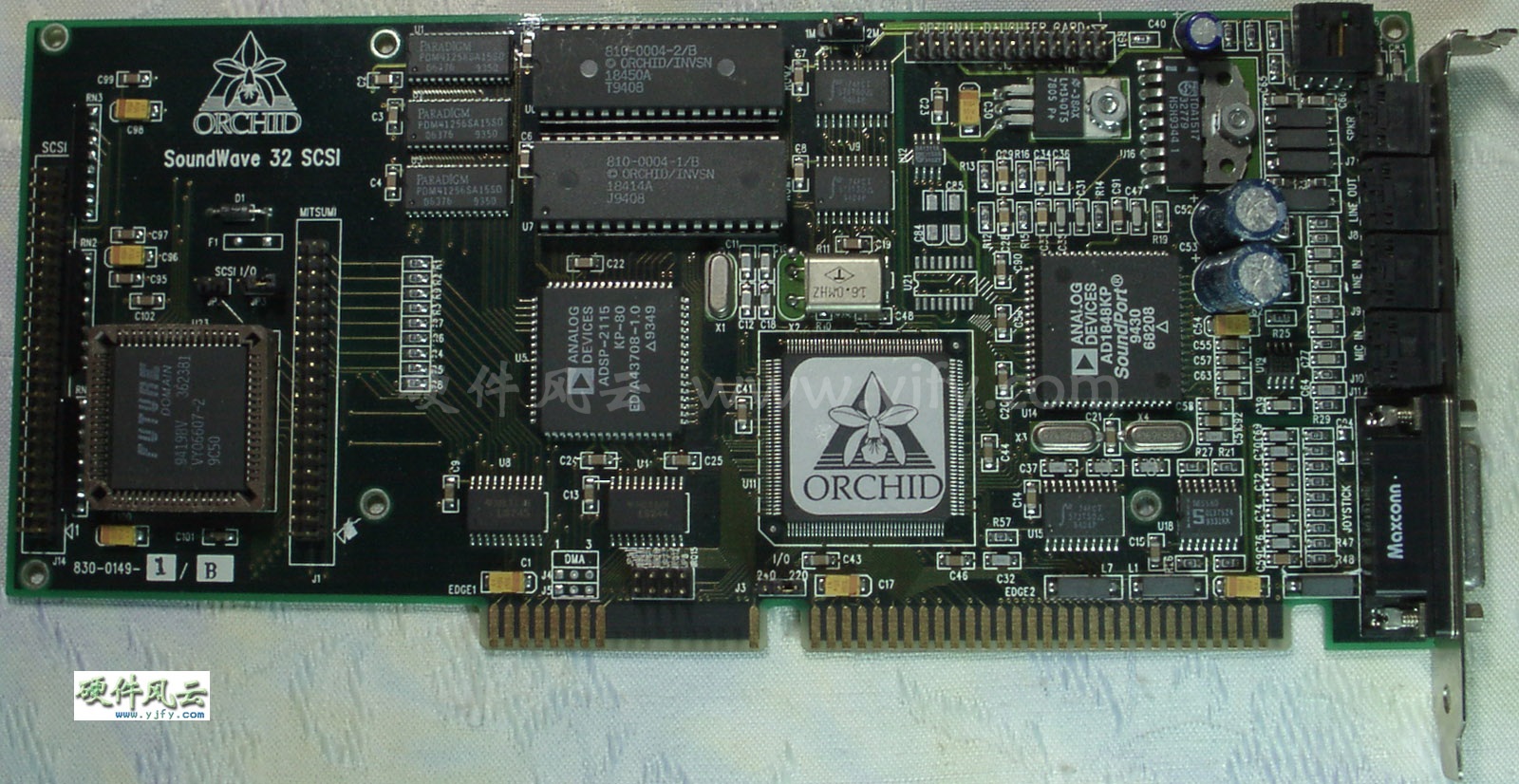      
Launched: 1994
FM synthesizer: OPL2 FM emulation
Audio codec: Analog Devices AD1848KP
DSP: Analog Devices ADSP2115.
Price when New: -
Supports Ad Lib, Sound Blaster Pro, Microsoft Windows Sound System, General MIDI, and Roland MPU-401 interface.
Like the SoundWave Pro, it has 2 MB of compressed samples onboard (a total of 56 wavetable synthesis voices). The SW32 SCSI cards all shipped with the InnoVision / InVision ROMs, which were an optional cost upgrade for the original SoundWave 32 card. In addition, all the SCSI and Studio cards came with a wavetable header.
Comes with SCSI-2 and Mitsumi CD-ROM drive interfaces.
The SoundWave 32+Studio is the same as 32+SCSI and 32Pro SCSI, but adds Orchid's WaveBooster 4FX high-quality wavetable synthesizer card, which features 4 MB of ROM samples (compressed to 2 MB?), built-in digital effects such as reverb, chorus, and is compatible with GS (General Synthesizer) specification.
User Manual
More Images
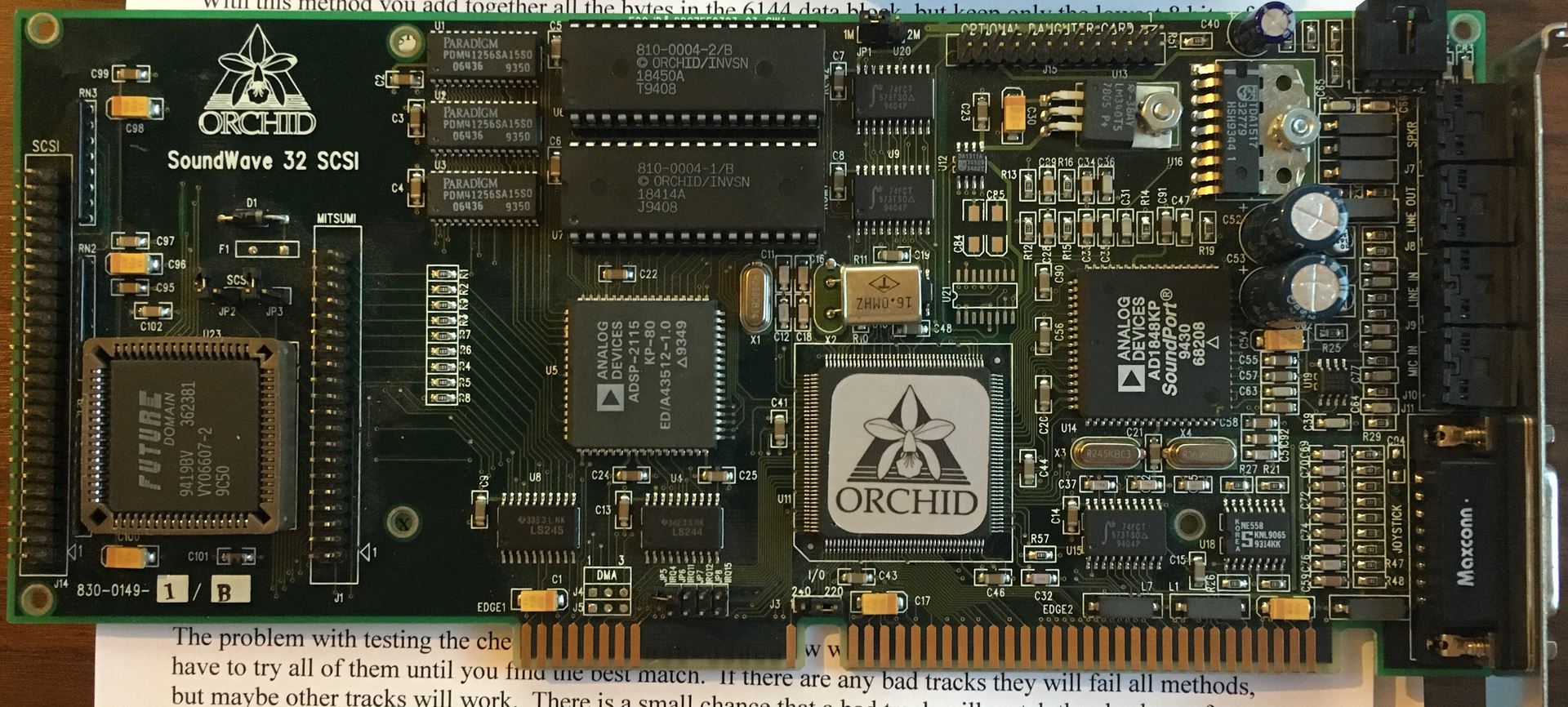
|
NuSound PnP 32       
Launched: 1995
FM synthesizer: Crystal CS9233
Audio codec: Crystal CS4232
CD-ROM Interface: Panasonic and IDE
Price when New: £129
FCC ID: DDS7EFNSND-16-PNP
Features plug and play compatibility, "Spatializer" 3D audio technology.
Supports Sound Blaster and Sound Blaster Pro, Windows Sound System, Roland MT-32, and General MIDI.
"Orchid is to launch a revolutionary new soundcard which combines wavetable synthesis with 3D surround sound and full games compatibility. The NuSound PnP supports the Intel/Microsoft Plug and Play specification, and is the first product to combine all these features onto a single board. The NuSound features 16-bit stereo sound and is compatible with SoundBlaster Pro, General Midi, Windows Sound System and Roland, amongst others. It is expected to retail at £129.00." PC Review, Iss.47 September 1995
The GM capability comes from the onboard Crystal Semiconductor/Dream SAM9233 in combination with the 1 MB ROM, Crystal CS4112. The patchset is either Dream's CleanWave 32, or the one they got into trouble over with Roland. It falls into my 'middling-quality' category of General MIDI wavetables, alongside the Sound Blaster AWE32/AWE64's EMU-8000 and EMU10K1 Sound Blaster Live! cards, some Ensoniq cards (OPUS and OTTO), and ICS Wavefront used on Turtle Beach Tropez, Maui and Rio cards.
Because the Crystal CS4232 does not contain an OPL3 chip embedded, there should be another 24-pin OPL3 chip somewhere on the board, but I cannot see such an IC. **UPDATE** The Crystal CS9233's host processor interface also includes FM synthesis support for Ad Lib-compatible audio as well as an MPU-401 (UART mode) interface.
Orchid Technology also produced an optional accessory for the NuSound PnP 32 in the form of the NuPanel. This was a 3.5" drive bay-sized control panel for audio inputs and outputs. It features sockets for all four of the ports on the faceplate of the card: Speaker, Line Out, Line In, and Mic, plus 3D on/off, mute and a volume control. Another optional accessory was Orchid's wavetable daughterboard, called WaveBooster. The WaveBooster had been released the year before the NuSound, and was considered their higher-end
User Manual
More Images
  
|




































